- All Articles
- Itineraries
- Guides and Tips
- Attractions
- Behind-the-Scenes
- Guest Stories
- Guides & Tips
- Universal Orlando Resort Deals
- Universal Studios Hollywood Deals

How the World-Famous Studio Tour Helped Shape Entertainment History
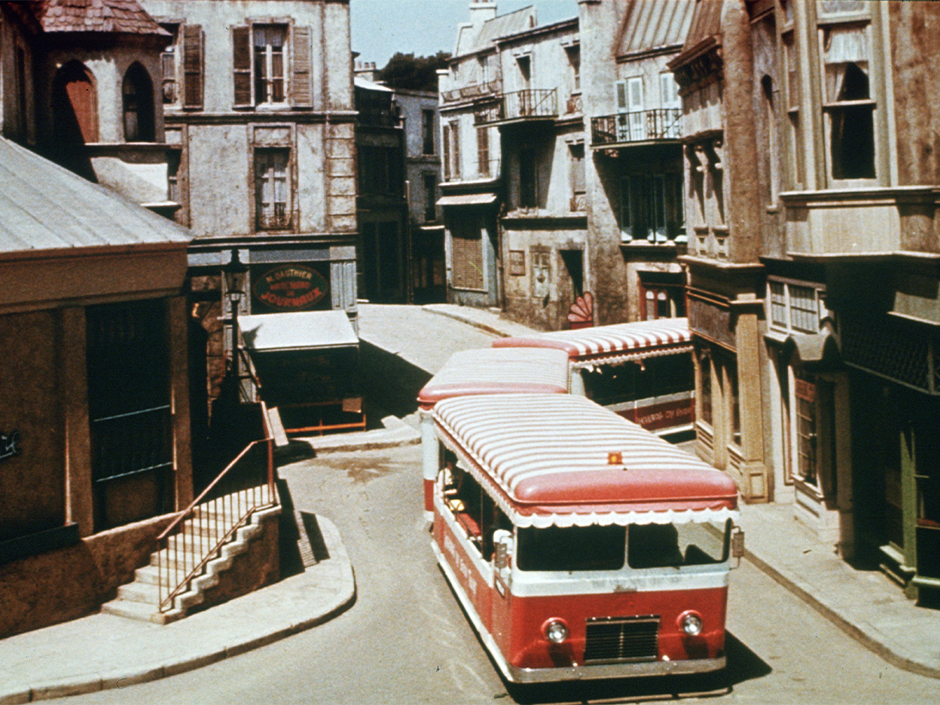
The World-Famous Studio Tour celebrates its 60th anniversary this year, and Universal Studios Hollywood is pumped to celebrate. After six decades of taking guests around the iconic Universal backlot — and in the process, transforming themed entertainment forever — you’d better believe we have a lot to celebrate. From a limited-time chance to hop off the tram for photo ops to adorable merch to delightful retro-inspired treats, the theme park has a whole lot of fun planned from April 26 to August 11, 2024 . But you know what’s even more fun than Glamor Tram sugar cookies? Reading up on your history. Yes, kids, that’s right!
After 60 years running, the Studio Tour has entertained more than 200 million guests. It’s tough to imagine the themed entertainment world without it. It’s become one of the top things to do at Universal Studios Hollywood , and is an absolute must for any Universal Studios Hollywood itinerary . But in its early days there was no guarantee the Studio Tour would last — let alone give way to the modern theme park. To get a sense for its impact, we dug into the Universal archives to look back at the history of the Studio Tour. You know, before it was world-famous. So let’s hop in the time machine for a quick Universal history lesson, shall we?
An Open Door Tradition
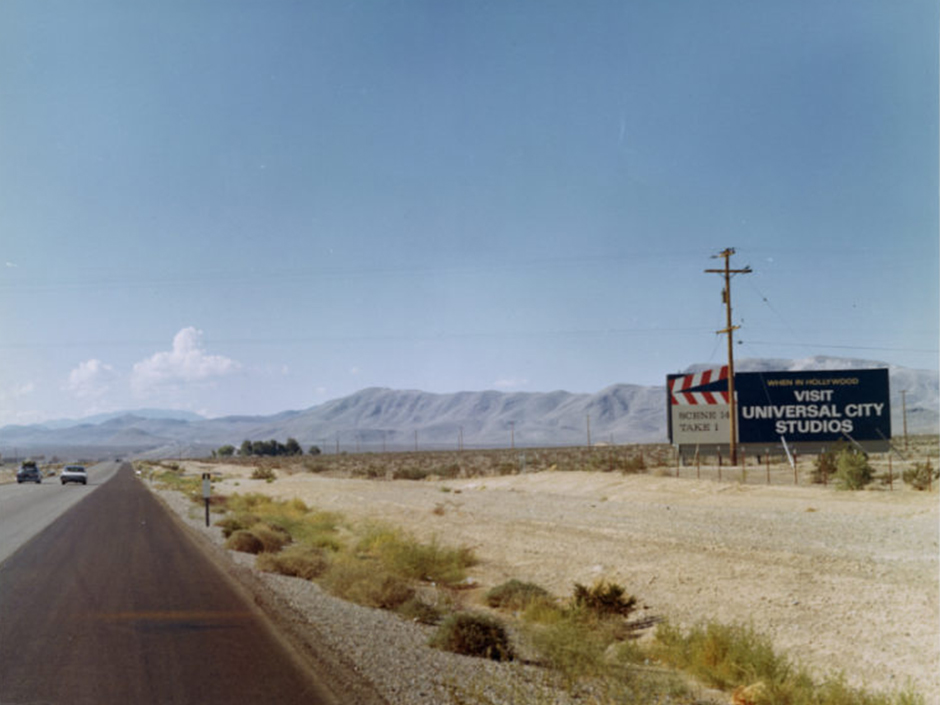
Universal has a long tradition of welcoming the public on set. In 1915, Universal Pictures founder Carl Laemmle opened the doors to spectators during filming. Guests paid 25 cents, took a seat in the bleachers, and watched as a show was filmed in front of them.
“You could literally watch movies get made,” says John Murdy, a Universal Studios Hollywood creative director who oversaw the refurbishment of the Studio Tour in 2000. Murdy actually got his start at Universal as a Studio Tour guide in 1989. Back in the 1910s, the tour was far less structured than it is today. “It’s kind of crazy,” says Murdy, referring to archival photos of the early audiences. “They just seem to be roaming around the property, walking around, checking stuff out.”
Sounds distracting, sure. But one crucial difference between 1915 and today? Films were silent. Audiences could watch a scene being filmed like it was a stage play, and react audibly without interfering with the filmmaking process itself. With the dawn of the talkies in the 1920s, Universal had to close its doors to guests, so as not to drive the sound guys up a wall.
A Little Side Project
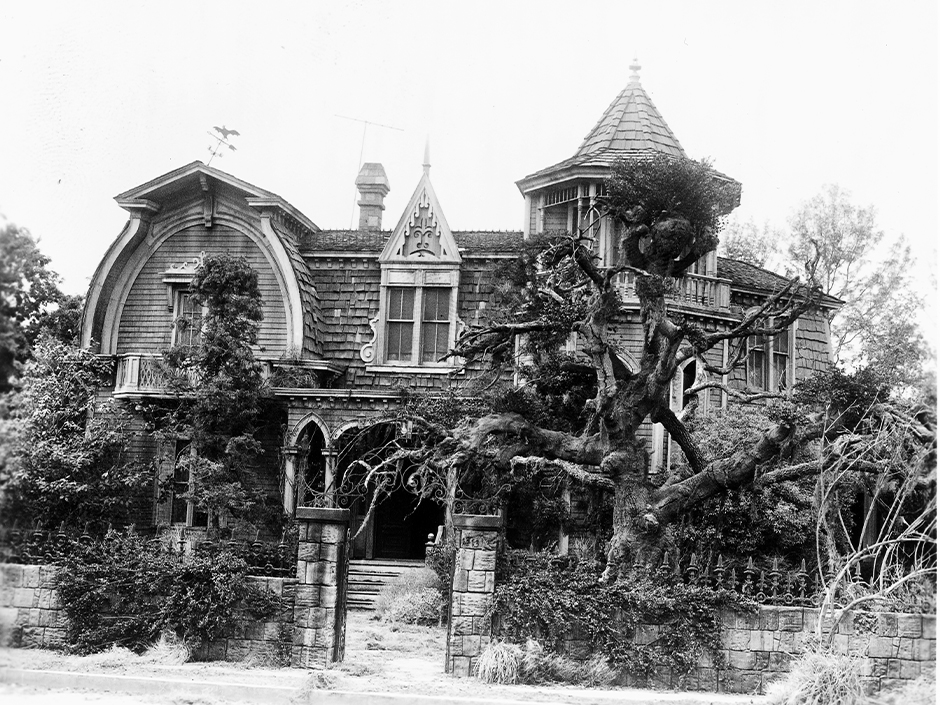
Fast-forward to 1964. Hollywood had changed quite a bit from the silent movie days. Not only did film have sound and color, but it had become a massive industry full of glitz and glamour. “It’s a weird era of Hollywood history,” says Murdy. “You’re coming out of the studio system days, and television is starting to impact the movie business.” With television competing for viewers’ attention, studios had to keep income coming in — and do so creatively.
It turns out, the studio execs just had to trust their guts. Or, rather — trust tourists’ guts. Prior to Universal’s own Studio Tour, third-party Hollywood tours would come onto the lot, take a swing around the sets, and stop for lunch at the Studio Commissary. With those tourist trips came a big uptick in lunch sales. How could they keep those lunch sales coming?
“That was literally the impetus for the Studio Tour,” says Murdy. “ How can we sell more lunches in the studio commissary? ”
A young executive named Jay Stein was tasked to manage this newfangled vessel for lunch sales. Stein recruited Barry Upson, a designer of the 1964 Seattle World’s Fair, to realize Universal’s own backlot tour. Hollywood legend Harper Goff, responsible for the looks of several iconic 20th century films, was brought on as the art director. Goff designed the now legendary candy-striped tour vehicles that criss-crossed the Universal backlot: the “GlamorTrams.”
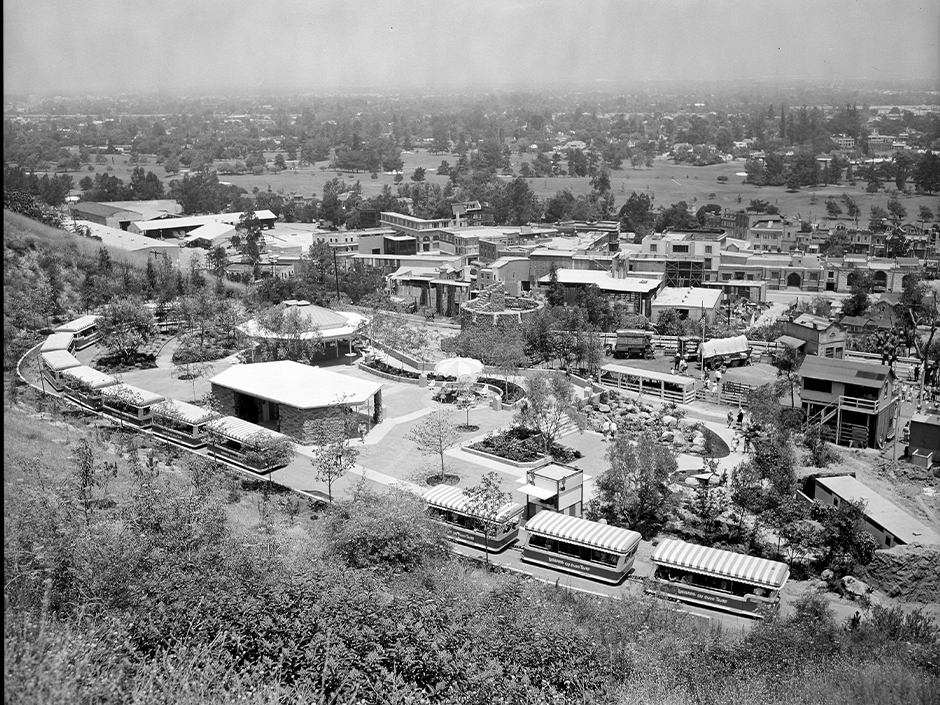
In its inaugural year, guests would pay $2.50 (or $1.25 for kids), then hop aboard GlamorTrams to tour the Universal backlot. The two-hour tour included a look at outdoor film sets, a makeup demonstration, a costume display by legendary designer Edith Head and a two-man stunt show. Compared to the whole theme park we know and love today, the Universal Studio Tour was modest to say the least. “It was literally a booth on a trailer on Lankershim Boulevard,” says Murdy, who remembers visiting the Universal backlot as a kid in the early 1970s.
We might take it for granted now, but regular folks getting to step foot on a movie set was a big deal at the time. Up to then, studios were shrouded in mystery and mystique. In a way, the Studio Tour democratized the moviemaking process — or at least, pulled back the curtain. As LA Times film critic Philip K. Scheuer wrote in 1964:
“You can now visit a bona fide movie and television studio…without having to contact a VIP who happens to be the relative of a bigger VIP, without presenting a letter from your hometown exhibitor or without, heaven be praised, making a last-ditch pitch to the motion picture editor of your favorite newspaper.”
What was once reserved for the well-connected was now a mass-market product. By its third year, Universal reported 8,000 guests per day.
An Opportunity For Innovation

Per his 2023 interview with the LA Times , Stein quickly realized two things in the early days of the Studio Tour. First, you couldn’t bank on the guests seeing an actor on the tour. They were unpredictable and at work. And some actors would even head for the hills at the sight of a GlamorTram. (Though, lots of them loved the tour. As Murdy remembers from his childhood visits to Universal, “We would always see Al Lewis, who played Grandpa Munster. Like, all the time. Whenever we came to Universal, he was just hanging out.”)
Secondly, Stein realized that studios aren’t inherently entertaining places. Sure, they’re where entertainment is created , but movie sets involve a lot of not-so-dazzling work in between shots. It was from these two observations that Stein realized that in order to survive, Universal needed to guarantee excitement on every tour. They needed to create illusions that would be (from production’s point of view) predictable, repeatable, and above all, entertaining. Guests, of course, must experience it as thrilling and un predictable, duh.
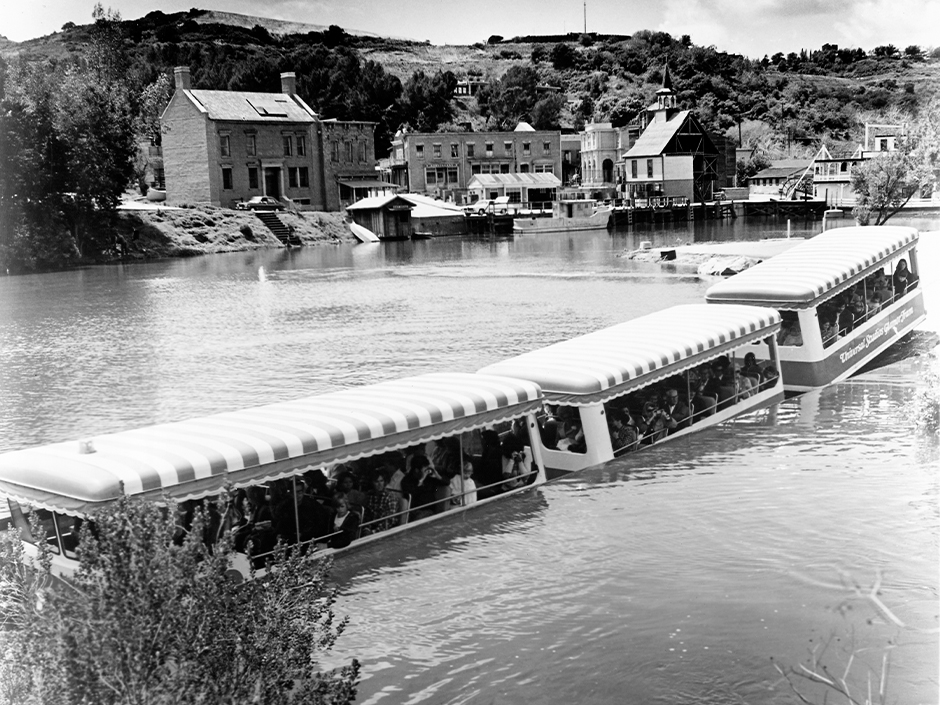
Throughout the following years, the tour expanded. It wasn’t just a peek behind the curtain anymore. It included a stunt show, an animal actors show, and a screen test comedy theater. A 1967 visitors pamphlet held in the Universal Archives advertised giant sound stages, a visit to a star’s dressing room, man-made lakes and waterfalls, a visit to the prop department, and exterior sets of New York, Europe, Hong Kong and the Old West. Over at the Visitors Center, guests would be treated to demonstrations by professional makeup artists, a showcase of film costumes, “push-button storms” on the Snow Set and the Rain Set, a peek inside the Munster laboratory (and the opportunity to “touch the button to bring Herman to ‘life’”), and more.
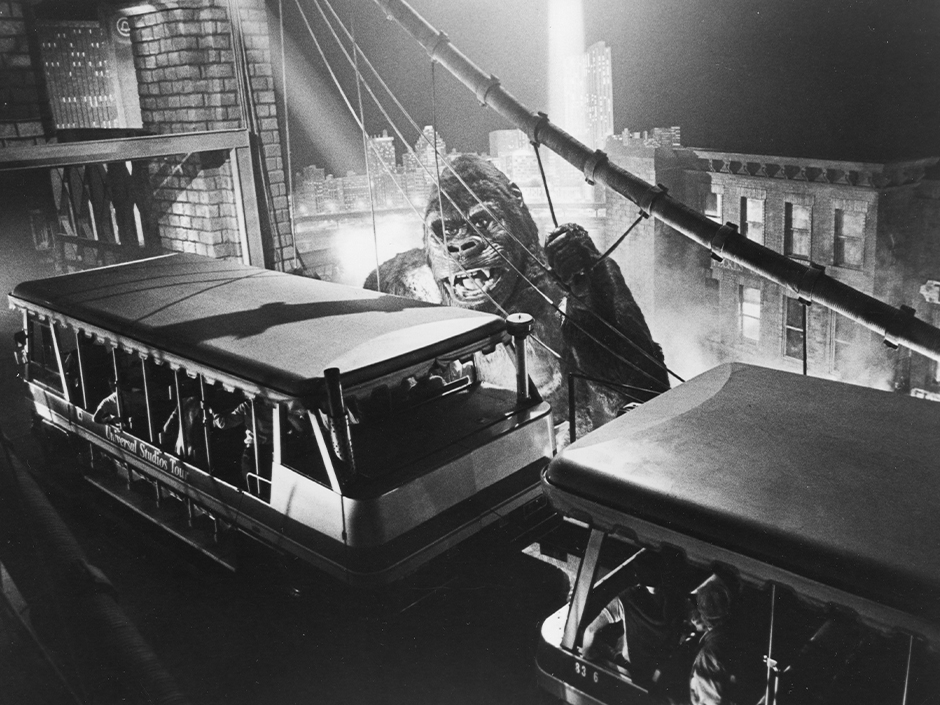
The Studio Tour had evolved from guests visiting a movie set to guests experiencing movie magic in real time. Universal pushed the limits of interactive entertainment further and further. In the ‘70s, they expanded the studio tour, with the additions of heart-pumping attractions like “Flash Flood,” “Parting of the Red Sea,” and “Jaws Lake” to the itinerary. In the ‘80s, they premiered “Earthquake,” a scarily realistic simulation of an 8.3 seismic tremor.
And what we now know as the Universal Studios Hollywood theme park came to life in the ‘90s, with attraction additions including “E.T. Adventure,” “Back to the Future: The Ride” and “Jurassic Park—The Ride.” Thanks to the Studio Tour, Universal found itself leading the industry in a whole new kind of fun.
A 21st Century Tour
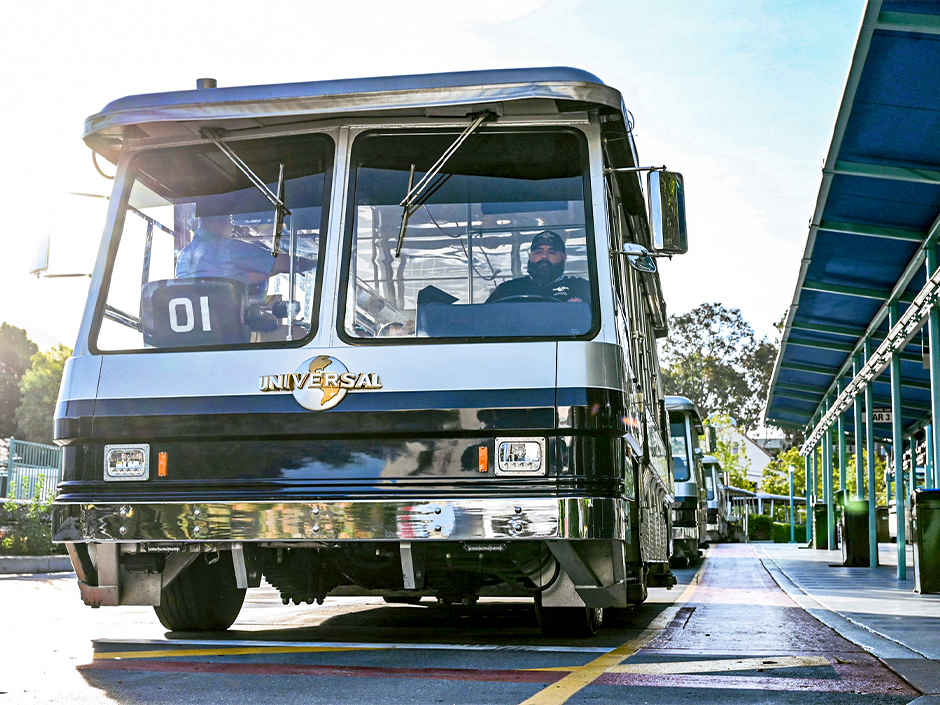
In 2000, the Studio Tour underwent a refurbishment to bring it into the new millennium. As the creative director on that project (and a former tour guide himself), Murdy made it his mission to bring the history of the Studio Tour to life on the tour itself. “The main thing I wanted to do was to connect the dots for the guests between the sets they were looking at and the movies they’d seen,” says Murdy. That’s when screens were added to the Studio Tour. Guests could now look out at a set on the Universal backlot, then immediately see a clip of how it had been utilized in a film or show. Murdy had a team whose job it was to watch movies and TV shows to find specific shots of the backlot they needed for the Studio Tour. “I’d be like, ‘I’m pretty sure they walk down Brownstone Street in this ‘50s movie. Can you find that shot?’” In doing so, the Studio Tour became a vehicle (pun intended) for bringing movie history to life — as it remains today.
Over the past 60 years, Universal Studios Hollywood has gone from entertaining guests with makeup tutorials, to natural disasters caused by movie magic, to adrenaline-pumping thrill rides. Attractions have come and gone, but what remains is the storied past of a studio that brings the screen to real life. And it all began with the Studio Tour. Giving the average movie fan a peek behind the curtain birthed a series of innovations that have changed entertainment forever.
What’s your favorite part of the World-Famous Studio Tour? Let us know in the comments below!
Universal Destinations & Experiences
Never miss a thrill. Subscribe now to get email updates from Universal Parks & Resorts.
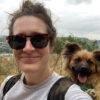
Grace Perry
Senior Editor, Universal Studios Hollywood. Lisa sun, Smithers rising, Disco Stu moon.
You Might Also Like
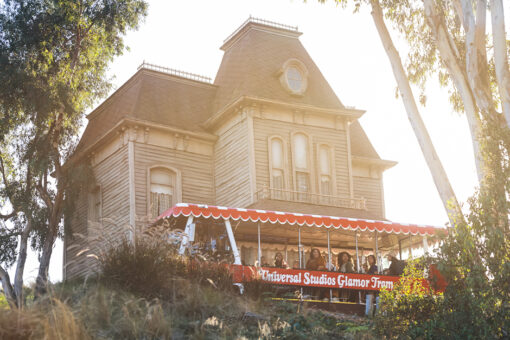
Guide to the Studio Tour 60th Anniversary Celebration at Universal Studios Hollywood
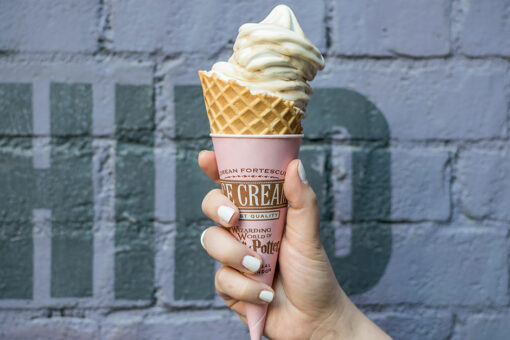
Florean Fortescue’s Ice-Cream Counter is Open at Universal Studios Hollywood
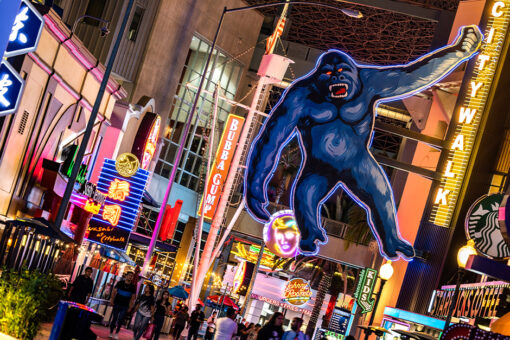
Guide to Universal CityWalk at Universal Studios Hollywood

Guide to the VIP Experience at Universal Studios Hollywood
No comments, leave a reply cancel reply.
Save my name, email, and website in this browser for the next time I comment.

Universal Studios Hollywood – History
IMP (International Motion Picture Company) founded by Carl Laemmle.
The Universal Film Manufacturing Company formed. August: Universal takes control of the Nestor Studio Operations in Hollywood. The Nestor ranch or Providencia ranch in the San Fernando Valley was called the “Oak Crest Ranch” in the film trade publications. Movie production begins. December 3: The Oak Crest Studio grounds were open to the Public. The location of Bison 101 brand of western movies.
July 10: With an eye to publicity opportunities, a second official opening is held of the Oak Crest ranch, as it is formally named ‘Universal City’.
August 13: Fifty Chimallo Indians from the Isleta reservation near Albuquerque, N. Mexico, are moved permanently to Oak Crest and installed in their new quarters, along with 100 head of horses recently purchased in New Mexico.
September: Universal City (Oak Crest Ranch) Tour began bus excursions from downtown Los Angeles
From Moving Picture World around 1913: Plans for the biggest outdoor motion picture studio in the world have been completed by the Universal Company and will be carried out within the next year. The Universal Company has just purchased 12,000 acres of land in the San Fernando valley near the railroad station of Lankershim and about eight miles from Los Angeles.
Surveyors are now laying it out and preliminary construction work is in progress. The property, which has been named “Oak Crest,” takes in among other natural objects, a mountain range, a river and a grove of timber. Leasing arrangements have also been made whereby the Universal Company will have the exclusive use of 8,000 acres of land adjoining its new property, with the privilege of purchase.
Those who have time and inclination may figure out for themselves that a tract of land eight miles long and four miles wide contains, in round figures, 20,000 acres, and this will give some idea of the magnitude of the Universal’s new plant.
There are to be six mammoth stages capable of accommodating the biggest productions, and two of them will be of solid concrete so that horses and heavy wagons may be used on them, and fires built if necessary. The stages are now being built.
At one place the river is to be dammed and an artificial lake constructed. A few buildings are now under way and others are to be erected without delay. The initial outlay will amount to about $60,000, but the plans call for the expenditure of more than $1,000,000 in the next five years.
It is the intention of the company to make the new plant merely an addition to its present holdings in this locality. In all probability the Western headquarters of the Universal Company will remain at the old Nestor plant, Sunset Boulevard and Gower Street, Hollywood. A large part of the Western output of the company is now being made at this studio, although the cameras will be sent out to the new place within a week.
On August 13 fifty Chimallo Indians from the Isleta reservation near Albuquerque, N. Mex., were moved to Oak Crest and installed in their new quarters. With them went 100 head of horses recently purchased in New Mexico. Accommodations for 300 people, in addition to the Indians, are being built and Mr. Gilmore, the Western general manager, says that the payroll will exceed $250,000 a year. [ The Moving Picture World, from Jerry’s Movie Locations ]
March: Carl Laemmle’s representative bought four tracts of land (Taylor, Boag, Davis and Hershey ranches) for $165,000. The 230 acre Taylor Ranch was to become the new Universal City Studio plant and the other three ranches the Back ranch.
Oak Crest Ranch / Universal operations began the move to the Lankershim, Universal City property.
Oct. 14. Universal City’s third grand opening; this event was for the Universal employees. At this time Carl Laemmle announced the official public opening was planned for February 2, 1915. All of Universal’s west coast operations had now moved to the Lankershim (Universal City) property.
Damon and Pythius was the first film wholly completed on the site in 1914.
From The Moving Picture World (October 3, 1914)
Building Universal City Great Enterprise of the Universal Film Manufacturing Company in California Rapidly Taking Form.
The Universal’s long heralded city, the aim for two years of Carl Laemmle and his associates, is rapidly becoming a concrete reality. In the new site in the San Bernardino Valley [sic] there is rapidly rising a city capable of accommodating 15,000 souls, built for the express purpose of making motion pictures, the first city of its kind ever constructed by the hand of man. This city has one peculiarity which marks it out from every other municipality. It is a chameleon, or a changeable city. When the plans for it were made the architects, landscape artists, engineers and directors were told to keep this one idea uppermost: the greatest usefulness with the least amount of construction. For that reason every building which has been put up or which is planned is designed to have a four or five fold usefulness. Every facade of every building is of a different type of architecture and usually represents a different kind of usefulness. For instance, a building designed primarily for a saddlery shop and a blacksmithy has one front elevation which looks like this kind of a building. From the other three angles it has the appearance of a Gothic hunting lodge, military barracks and a Wild West ranch. In addition to this any one of these front elevations can be changed in thirty-six hours to represent an entirely different kind and character of building. This idea has been carried out throughout the entire city and landscapes have been treated in the same way–that is, viewed from one side they present a certain aspect; from the opposite direction the character, climatic or sectional, is of an entirely different sort. This will enable a director who under ordinary circumstances would have a certain number of good locations in such an extremely favored site as Universal City to construct from ten to twenty more scenes with the same locations, which can be changed under the skillful guidance of the general manager. There is work and work galore in Universal City before it will begin to represent the elaborate and crafty plans of Mr. Laemmle and his lieutenants. In the first place after the plans of the city had been made the different streets had to be paved, and it was all done with asphalt and macadam. Every stream and gully had to be spanned by a bridge or viaduct and here comes the first intimation of how changeable the complexion of the city can be. Every bridge is so constructed that it can take on the aspect of a Japanese arch bridge, a Roman stone paved bridge or a steel cantilever bridge, or in fact any other kind of a bridge for which a director has need in the production of a scenario. All of the streets had to be scientifically paved and piped for gas, electricity and sewer mains. The main boulevard of the city is six miles long and this taken in conjunction with other main streets and cross streets will give the reader an idea of the amount of work which the Street Department alone had to do. The piping for water alone was an important item, for every building is so equipped, and the city itself is probably supplied with the best water which can be obtained in California. Its reservoir is fed by seven artesian wells which give water 99 per cent. pure at the rate of 300,000 gallons per day. The roadways of the city are peculiar in that they are made in different widths and the styles of top dressing so that there will be as great a variety in this respect for the director to choose from as possible. The zoo, which will be housed in especially constructed buildings and cages, has been taken intact from the ranch and with the additions which have since been made to it it is now the largest and finest privately owned menagery in the world today. The administration building will cost $30,000 and its four facades are all different, representing different styles of architecture and apparently different exteriors. The laboratory which is being built has also the same peculiarity of exterior appearance and will cost $25,000. An exhibition theater which takes on either the appearance of a city or a country theater at the behest of a director will cost the company just exactly $8,000. There are barracks for the housing of the Universal’s troop of expert cavalryment and a bunk house for the cowboys. All of these are modern, clean, sanitary and wholesome and beside this they can be used for many other things from the moving picture standpoint. One of the most picturesque spots in the city is the Indian village, which is the largest in America and is inhabited by a tribe of redmen who are encouraged to pursue their life and adorn themselves as grotesquely as possible. The wonderful revolving stage is one of the most up-to-date features of this city. The location of the stage has been chosen with a view to vistas which can be seen through the windows. The wardrobe department is a building standing alone and occupies a floor space of 50 x 100 feet. It contains a wardrobe of every conceivable sort which is valued in the rough at about $35,000. In addition to this the costume shops which are nearby are so arranged that they [can work] to turn out the designs which are required by every [period] dress from the era of palm leaf girdles to the present [?]. [The] costume shops contain twenty electrically operated weaving machines and the work is supervised by one of the best known costume designers obtainable, who is able to outfit a picture in the proper costumes demanded by any age. There are two hospitals and infirmaries thoroughly equipped with every medical equipment for surgical and pathological remedy and these are under the direction of the two Universal physicians, Doctors Lloyd Mace and F. Lamberson, assisted by a corps of trained nurses. Treatment in these hospitals is also defrayed by the Universal. The first notable incident of the mobility of the new city was shown in the preparation of a thrilling scene for “Trey of Hearts.” The director knew of just the proper location for a fire and for a daring rescue by means of a rope acting as a pendulum, but sad to relate this scene is in Jersey City, N. J., and that was three thousand miles away. It was out of the question to take a company that distance in order to stage this one scene, and even then the city fathers of the city on the heights would not have consented to the total destruction of one of their office buildings even for the edification of ten million moving picture fans, who are following the destinies of this stirring serial drama. The only thing to do was to reconstruct the scene from buildings already standing and this was done in three days, and the result was so perfect that New Yorkers who gazed upon it in wonder were compelled to pinch themselves before they could realize that they were in California and not New Jersey, but the scene was speedily burnt to the ground and this newest of cities, the Chamelon, once more resumed its work-a-day color. [From Jerry’s Movie Locations ]
From The Moving Picture World (date unknown) Improvements at the monster motion picture plant of the Universal company at Oak Crest in the San Fernando valley are going forward rapidly. There are now four big stages completed besides a Western town which has been built for the double purposes of backgrounds and utilitarian use. The fixed population at Oak Crest, including the Indians now numbers about 300. The company has about 20,000 acres of land with a sure enough mountain range on the ranch and by the first of the year will have the largest motion picture plant in the world. [ The Moving Picture World, from Jerry’s Movie Locations ]
From The Moving Picture World (date unknown) UNIVERSAL CITY MOVES. Big Undertaking Conducted Rapidly by Large Force of Employees Many Improvements in Big Plant. The work of removing Universal City from its temporary location a few miles outside of Hollywood, California, [Providencia Ranch] to its permanent site on the new ranch, purchased by the company for that purpose is going forward with a rush. Under the direction of Wallace Kerrigan, buildings that have long seen service in the production of the famous Universal dramas and western comedies, are being razed to the ground, loaded upon big auto trucks and flat-topped wagons and hauled over two miles of mountain roads to the new ranch. The first part of the original city to be moved to the new site was the Zoo, and the day of its removal was one of intense excitement to everyone about the ranch, particularly to Mr. Kerrigan and to James Barnes, the head animal trainer for the Universal Company. Lions and tigers, leopards and coyotes, bears and wolves, together with the hundred odd animals that go to make up the menagerie were loaded cages and all, upon the trucks and driven growling and roaring along the canyon road to the New City. The roads are rough and rutted and for the most part built “on end,” and a dozen times as the wagons lurched and twisted this way and that, the danger of overturning the wagons or of tipping off the cages was imminent. As for the construction of the New City, itself, only by actual observation can any time be gained as to the speed with which it is going up. Already the new cages and pens for the animals have been partitioned off for the thoroughbred English saddle-stock, corrals strung for the heavier draft animals and hay barns stand finished and partly filled with bales. The foundations for fully one-half of the buildings have been started and the frameworks for the greater part of these are already being raised, while several of the buildings stand completed and ready for occupancy. William Horsley has charge of this work. Among these is the quarters for the Universal crack cavalry troop. It consists of a long, well-lighted living room and equally large, light bunk room, concrete floored baths and lavatories and everything that Manager Bernstein of the Hollywood Studios, could think of to add to their comfort. Electricity is used for lighting, and running water has been piped in from a clear, cold spring in a neighboring canyon. Needless to say the boys are overjoyed and are waiting anxiously for the orders to move in. A quarter of a mile of concrete side walks has been laid and many times that amount soon will be in. A temporary cook house has been erected to serve until the permanent dining room has been completed. The old original Universal City will soon be a thing of the past, but, like the Phoenix of old, up from the ashes is arising the head of a newer and better Universal city, destined to be the western home of the leader of film manufacturing companies. [The Moving Picture World]
When Laemmle learned the new facilities would not be ready by February, the official opening date was moved to March 15,1915. The delay allowed the two public relations events, the Great Train Ride from the east coast and a Beauty Contest Parade entering the main gates on March 15, 1915.
The Oak Crest Ranch became known as the “Universal Ranch” until it was leased as the Lasky Ranch in 1916, the site today is Forest Lawn Memorial Park (Hollywood Hills)
Universal City had an official opening event on March 15 1915
Carl Laemmle invited members of the public to watch films being made (in exchange for a 25 cents admission fee). A chicken lunch box was also available for a nickel; the first step towards the Universal Studios theme park we know today!
Extensive outdoor construction on the backlot for Von Stroheim’s ‘Foolish Wives’
MCA (Music Corporation of America) is formed, as a booking agency for bands. Founder Dr Jules Stein and President Lew Wasserman would have a large part to play in the future of Universal in the 1950s.
July – Construction starts on Stage 28 for The Phantom of the Opera
Stage 12 is constructed, for the innovative musical “Broadway” – brand new methods were created for moving the heavy early cameras, and this was the first movie to be lit entirely with tungsten lamps, allowing a lot more control and more subtle lighting.
Following the advent of “talkies” around 1930 the studio had reluctantly to close the doors to paying visitors as the stages were not sufficiently soundproofed.
As studio earnings were lower than expected, Carl Laemmle had to take out a loan of $750,000 to keep the studio afloat as Showboat (1936) was due to start production shortly. He agreed to a gamble – if he didn’t repay the loan on time, the investment company Standard Capital could buy Universal for a flat $5.5m. Unfortunately, he lost the gamble.
Universal Pictures bought by Standard Capital. The studio is renamed ‘New Universal Studios’.
Showboat is released less than 2 months after Standard Capital takes control, and is a big box-office success. The Laemmle family can only watch from the sidelines.
Carl Laemmle dies on 24 September, age 72, having lost the studio he built from scratch.
Universal merges with International Pictures to become Universal International
Decca Records becomes the new owner of Universal .
Gray Line Bus Tours have Universal International Studios part of their Hollywood tour, along with movie star homes and other Hollywood landmarks such as Will Rogers home and Disney Studios. The bus travelled around the backlot, seeing Colonial Street, Courthouse Square, the Tower of London set, western streets, and learning about the use of facades etc. Although there were no ‘attractions’ on the tour, visitors appreciated the variety of different locations that had been built on the backlot.
$500,000 fire destroys the New York Street backlot sets.
MCA buys the Universal lot, mainly to enable them to make TV programmes using the backlot and studio facilities. Construction starts on Stage 1.
Spartacus , directed by Stanley Kubrick, makes extensive use of the backlot and studio facilities.
Start of Tram Tours. The studio commissary (staff restaurant) was in need of a business boost. Albert Dorskind (1922-2004) was the president of MCA at the time, and realised he could increase studio income by inviting tour buses to drive through the lot and stop off at the commissary during quiet periods. His first contract was with Gray Line Tour buses, but it soon became clear that the most lucrative move would be to run the tours themselves.
The Jack Benny Show moved into the newly opened Stage 1.
1962 to 1964: Revue Studios Tour – conducted by Tanner Gray Line Motor Tours, “Dine with the stars” and a bus excursions on the backlot.
MCA acquires Decca and also Universal Pictures and leaves the talent agency business behind.
To Kill A Mockingbird is released, having shot entirely on the backlot.
July 9: The MCA Tower (“Black Tower”) on the Front Lot is dedicated. The ceremony is commemorated by the production of “Golden Rivets”.
Universal Studios Hollywood officially created. Albert Dorskind (see above) persuades MCA Chairman Lew Wasserman to invest $4 million in designing trams and building food courts, parking lots and restrooms. [The reported date for the official opening of the new Studio Tour varies from June 17 to July 15th 1964 – no-one knows for sure!! The official Universal date is June 17th, but I’ll stick with July 15th, as that date is reported as the start of the public tram tours in newspaper reports from 1964.] July 15 1964 , the Universal Studios Tour begins featuring newly created pink and white-striped GlamorTrams . Along with the studio commissary, there was also the following on the menu (served from the commissary basement)
- An exhibition of designs by celebrated movie costume designer Edith Head.
- A brief make-up demonstration (show production by Bud Westmore)
- A push-button monster
- A walk through Doris Day’s dressing room (not in the commissary basement!)
- A Western shootout performance by two stunt men (this wasn’t in the commissary basement either).
The total staff dedicated to this part of the studio operation was one ticket seller, two guides and two tram drivers. Admission was $2.50 for adults and $1.50 for children. From this point, the evolution was gradual, but steady.
March 28: Universal City Schoolhouse on the Universal frontlot is demolished. Young stars such as Ann Blyth, Donald O’Connor, Deanna Dean had classes there.
Visitor’s Entertainment Center built at a cost of $5 million “where special effects are illustrated along the movie streets of the world”. The visitor entrance to the Universal Studios Tour was moved from Lankershim to the upper lot. Various photo opportunities were added to the tour. The Stunt Show is performed in the Action Arena.
May 15: $1million fire destroys a large portion of the backlot sets .
The Universal Tour Entertainment Center (Upper Lot) is opened for the start of the Studio Tram Tour, with the Stunt Show now sharing the Action Arena with an early incarnation of the Animal Actors show.
Ma and Pa Kettle Farm is opened to show off animal actors (date is approximate)
Flash Flood set added to the Studio Tour.
The Sheraton Universal Hotel opened to accommodate guests in Universal City.
Universal Amphitheater under construction.
Animal Actors Training Stage appears on the Upper Lot.
Adam 12 ‘Stage 70’ attraction opens and the stunt show moves to the newly constructed Universal Amphitheater .
Torpedo Attack / Submarine set added to the Studio Tour.
Dirty Harry shot on New York Street
The outdoor Universal Amphitheater becomes a rock concert venue as the park expands across the hills overlooking the backlot. The Amphitheater is the venue for the Stunt Show during the day, and on summer evenings it’s a high-specification concert venue.
The parting of the Red Sea becomes a feature of the Universal Studios Tour.
The Burning House sets the Studio Tour “aflame” for the first time.
The Universal Amphitheater expands to 5200 seats to accommodate rapidly rising concert attendances.
Rockslide added to the Studio Tour, on the hillside currently supporting the rear of the Simpsons Ride building.
Collapsing Bridge added to the Studio Tour.
Earthquake shot on soundstages and New York Street sets
August: The “ Land of 1000 Faces Make-Up Show ” is premiered in an open-air auditorium on the future site of the Castle Theatre.
Treacherous Quicksand Pit becomes a feature of the Stunt Show.
The Runaway Train becomes a feature of the Universal Studios Tour.
The Ice Tunnel added to the Studio Tour, inspired by the Clint Eastwood movie The Eiger Sanction . The attraction has been rethemed twice since construction and is currently known as The Curse of the Mummy’s Tomb .
April 10: Jaws Experience (featuring a 25 foot long shark) begins terrorising the Studio Tour, following the outstanding success of the 1975 movie. The original “ Bruce the shark ” prop from the movie goes on display in the Upper Lot.
The Screen Test Theater makes it’s debut on the Upper Lot using Emergency! as it’s theme.
Six Million Dollar Man® / Bionic Woman® Testing Center (“BIONIC” special effects demo) opens in Stage 32, replacing the Special Effects Stages.
Airport ’77 opens in the Screen Test Comedy Theater.
Carl Laemmle Jr. dies, 40 years to the day after his father.
Battle of Galactica attraction is added to the Tram tour. The tram is stopped by a robot in a tank and ordered into a soundstage where an elaborate robotic laser attack is enacted on the tram. The Battle show building replaces the Rockslide – the whole attraction took 9 months to build.
Universal Amphitheater closes for renovation (including a roof) and reopens in 1982.
The Castle Dracula show opens in the newly constructed Castle Theatre
John Landis comedy The Blues Brothers shot on the backlot and on a number of locations.
Backlot location Colonial Street is moved across the backlot. Some of the original Colonial Street is used to construct Industrial Street.
Womphoppers restaurant opens as the Visitors Centre expands. ? Fung Lum restaurant opens just off the property.
June 6 & 7: Japanese Cultural Festival
Universal Amphitheater reopens with 6251 seats.
The Best Little Whorehouse in Texas shot on soundstages
November 29th – Universal Studios Hollywood is featured in the “Steel” episode of The A Team , season two. Blue and white trams can be seen, along with a green trolleycar-type tram used for VIP tours. Other attractions visible include Jaws, The Burning House and The Ice Tunnel.
The Adventures of Conan: Sword and Sorcery Spectacular opens (created with Landmark Entertainment ) in the Castle Theatre, based on the film Conan the Barbarian . Landmark were also working on the 2010 Special Effect Stage .
The A-Team Live Action Stunt Show premieres on the future site of Miami Vice and WaterWorld .
Knight Rider car – A unique opportunity to sit in Michael Knights car KITT, and ask him/it questions.
February 8-10 and 15-17 – He-Man & Masters of the Universe themed meet and greet
July – Transformers themed meet and greet on the Upper Lot.
Courthouse Square is transformed forever for Back to the Future
The Color Purple shot on the backlot and on location.
March 18 – At the time the world’s largest animated figure, weighed in at seven tons, measuring over 30 feet tall, covered in 660 pounds of fur and with a bad case of banana breath – King Kong is added to the Studio Tour in his own 26,000 square foot New York themed soundstage. He’s modelled after the star of Dino de Laurentis’ 1976 movie version.
?date – Sound Tracks recording studio opens on the Upper Lot.
September 4 – Fire destroys Spartacus Square sets.
The Star Trek Adventure debuts.
Miami Vice Stunt Spectacular occupies the arena adjacent to the Universal Amphitheatre. The TV series was in production 1984-1989. This show replaces the A-Team Live Action Stunt Show .
Fall – Another stop on the ever-expanding Studio Tour is the world’s greatest natural disaster: Earthquake – The Big One . Simulating an earthquake measuring 8.3 on the Richter scale, its opening marked the most successful attraction debut in history. Earthquake the movie was released in 1975. The “soundstage” in which the attraction is housed was specially built and replaced the Tower of London set adjacent to Denver street on the backlot.
Some of the house sets on Colonial Street are rearranged for Tom Hanks comedy The ‘burbs.
Universal Studios Hollywood has a record year for attendance, with visitors increasing by 21%, which is down to the runaway success of the Earthquake attraction.
MCA purchased by Matsushita Electric Industrial Co. Ltd.
November 6th – A large fire on the backlot destroyed up to a fifth of the permanent backlot sets including the New York Street, and some period cars for the Sylvester Stallone film Oscar . A security guard was later charged with arson.
May – Fievel’s Playland is the first children’s play area, including a live outdoor stage-based musical based on “ An American Tail ” (1986), on the future site of T2:3D.
June – Universal Orlando opens in Florida. A much larger area means larger versions of the Hollywood favourites are possible. Among the first attractions are versions of the Earthquake, Jaws and King Kong attractions at Hollywood that are single self-contained attractions rather than being parts of the tram tour.
March 15 – Following an unprecedented multi-million dollar expansion, the lower lot (named the “ Studio Center ”) is added to the attractions with the ¼ mile Universal Starway escalator linking it to the upper lot. The Studio Tour and World of Cinemagic are also now based at the Studio Center, as is the Lucille Ball exhibition “ Lucy: A Tribute .”
June In the new lower lot The E.T. Adventure premieres, based on Steven Spielberg’s enduring saga, inviting guests to soar on starbound bicycles in an effort to help E.T. find his way home.
The Blues Brothers debut performance in the park.
Summer: Beetlejuice Graveyard Revue opens. The show was originally in an outdoor venue and moved into the Castle Theatre later during it’s 7 year run.
July: The fiery Backdraft attraction opens with a burst of heat, based on the Ron Howard film.
September 24: A fire in air-conditioning ducts above Backdraft causes the attraction to be evacuated. No members of the public panic as they thought the black smoke was part of the presentation.
The Burning House is finally extinguished as Backdraft takes over as the primary flaming attraction, and the Battle of Galactica is finally won (or lost) in preparation for the construction of Back to the Future – The Ride .
The Rocky and Bullwinkle Show opens (outdoor stage next to War Lord Tower).
Beethoven shot on the backlot, at a new neighbourhood built at the upper boundary of the studio.
May – Universal Citywalk opens immediately outside the gates of the theme park.
June – The first high-technology thrill ride opens, positioned at the edge of the Upper Lot; the simulator-driven Back To The Future – The Ride based on Robert Zemeckis’ 1985 film.
Flintstones Musical Revue opens (replacing Star Trek Adventure ) and Universal Studios Hollywood celebrates 30 years of operation with a laser and fireworks spectacular called Spectrablast and a giant magic show Cinemystique: Illusions of the Night .
The Seagram Company Ltd. buys control of MCA and Universal Pictures .
July 4th – The Making of Apollo 13 attraction opened
Autumn – The live stunt show Waterworld – A Live Sea War Spectacular opens, based on the Kevin Costner epic, following Universal’s history of pushing the envelope on blending high-tech special effects, pyrotechnics and human stunt artists. Part of the Miami Vice stunt show set is retained, along with some props actually used in the Waterworld movie.
30 November: Fire Station 51 facility is dedicated.
Matt Stone and Trey Parker (long before South Park) make the short film “Your Studio And You” parodying 1950’s corporate films. The 15 minute black & white film is commissioned by Universal executives, shortly after the studio was purchased by Seagrams. Click for more information .
J urassic Park – The Ride opens in the lower lot, setting new standards for ride design and theming, and bringing Steven Spielberg’s 1993 film roaring to life! To accommodate it, the Studio Tour departure point moves back to the Upper Lot, where it’s situated today.
January 2 – The Flintstones Musical Revue closes
July 14th – A VIP tram catches fire at Six Points Texas – no one is hurt, but the tram and a section of Livery Stable set is damaged.
September 6th – A fire in a chemical store adjacent to Courthouse Square destroys the north side of the square. The sets are immediately rebuilt to the same designs.
Totally Nickelodeon attraction opens (replacing the Flintstones Musical Revue ) and Fievel’s Playland closes in preparation for the construction of the show building for Terminator 2: 3D .
The Land Before Time show opens.
The Ice Tunnel is rethemed as a mine shaft through a volcano for Dante’s Peak.
Aquazone is a water play area adjacent to the future site of Terminator 2/3D .
Feb 18 – Victoria Station restaurant becomes Marvel Mania – a restaurant chain venture by Planet Hollywood and Marvel Entertainment.
June 29 – Small Solders – Behind the Scenes Experience
Western Shoot Out in Denver Street
May – The epic adventure Terminator 2/3D opens, featuring a state-of-the-art multi-million dollar 70mm 3D movie along with incredible live action effects and stunts. The theatre is custom built to house this attraction on a reinforced parking structure.
September – Beetlejuice Graveyard Revue closes after a 7 year run. The Castle Theatre is “dark” for the next two years, apart from one-off special shows and corporate events.
September 10 – Marvel Mania restaurant closes as the restaurant chain goes out of business.
November 18 – Globe Theatre opens in the former Winston’s Grill building opposite Terminator 2/3D . The venue is used for corporate events, meetings and banquets.
The Sheraton Universal Hotel is remodelled.
June 9 The Rugrats Magic Adventure replaces Totally Nickelodeon .
June 10 – Walkthrough maze based on the animated film Chicken Run opens on the Upper Lot in the former Marvel Mania restaurant.
Summer – The Studio Tour is updated with new LCD monitor screens, JBL sound system and DVD playback in the redesigned tour vehicles.
November 17 – Grinchmas event across the park to celebrate the release of The Grinch , filmed entirely on the studio lot.
? Shrek Live show outside Castle Theatre.
Spring – New 30,000 square foot interactive attraction, Nickelodeon Blast Zone including The Wild Thornberry’s Adventure Temple. The War Lord Tower , a feature of the Upper Lot since the start of the Tram Tour in 1964, is demolished to make room for it. The water play area Aquazone , adjacent to Terminator 2:3D is rethemed as Coke Soak .
April – Animal Actors Stage has been rebranded to become Animal Planet Live!. The Animal Actors show moves into the Castle Theatre while the refurbishment takes place.
May – The Mummy Returns Chamber of Doom opens on the Upper Lot. The Ice Tunnel is rethemed once more as The Curse of the Mummy’s Tomb to tie in with the Mummy films.
The Jaws Experience is upgraded with new fire effects to become Jaws on Fire!
September – Rugrats Magic Adventure show closes to prepare for Shrek 4D in 2003.
6th January – Wild West Stunt Show closes. The arena it occupied is still unused today apart from being transformed into a maze during the Halloween Horror Nights event.
March – Special Effects Stages opens spread across three former Cinemagic sound stages. Gladiator, Jurassic Park and The Mummy are featured in the demonstrations.
May – Spider-Man Rocks! opens in the Castle Theatre.
Frankie Muniz comedy Big Fat Liar brings the backlot and Prop Warehouse onto the big screen.
14 March – E.T. The Adventure closes to make room for Revenge of the Mummy .
May 10 – Shrek 4D opens having replaced The Rugrats Magic Adventure Show .
Bruce Almighty shot on New York Street and Falls Lake
January – The Mummy Returns: Chamber of Doom walkthrough is closed to be rethemed.
May Van Helsing: Fortress Dracula walk-through maze opens, replacing The Mummy Returns: Chamber of Doom.
June 25 – Revenge of the Mummy indoor rollercoaster opens having replaced E.T. The Adventure .
August 2nd – Spider-Man Rocks! closes.
Fear Factor Live opens in the Castle Theatre.
June 29th – War of the Worlds set added to the Studio Tour.
October – The Collapsing Bridge is quietly retired from the Studio Tour. The vintage attraction was the second mechanical effect to be added to the backlot tram tour (in 1972, after the Flash Flood in 1971) and is believed to have been decommissioned due to the cost of running repairs. (It’s put back into operation in 2008).
December 14 – King Kong appears on the Upper Lot fresh from the New York premiere.
December: The NBC Universal Vision Plan is launched, proposing expansions / updating of production facilities, moving a number of Studio Tour attractions, adding new attractions and building a large residential development on areas of the backlot.
The Animal Planet Live stage is rethemed back to Universal Animal Actors .
May 26 – Picture Cars and animatronic dinosaurs are moved into position and the Greens Department is renamed the Transportation Department.
June – The new Studio Tour is unveiled. The Fast and the Furious replaces the Dantes Peak model set . New HD screens, a new Studio Tour video host (Whoopi Goldberg), new video introduction to the Flash Flood (from Al Roker, NBC weatherman) and a photo opportunity featuring the hosts of NBC’s Access Hollywood finishes a great series of upgrades.
July – The upgrades continue with a new street stunt show featuring Zorro , adjacent to the sadly missed (still empty) Wild West Show venue, and new paintjobs all over the Upper Lot.
October – Halloween Horror Nights 13 runs over 7 nights
November 4: Van Helsing walk-through closes to be replaced by Universal’s House of Horrors in Spring 2007.
Evan Almighty in production on Stage 27 and Falls Lake.
February – Refurbishment of the CityWalk Cinema complex.
March 31 – Universal’s House of Horrors opens in the former Van Helsing building.
King Kong moved from the Upper Lot
September: Back to the Future: The Ride closes
October: The Kwik-E-Mart Simpsons merchandise store opens in the former Time Depot building next to the future home of The Simpsons ride.
31 December : Marvel characters disappear from USH.
National Treasure: Book of Secrets in production on Stage 12 and Falls Lake.
Spring: A new simulator ride based on The Simpsons opened.
1 June: A massive backlot fire destroys the New York Street facades, half of Courthouse Square, and the King Kong attraction.
The Collapsing Bridge is refurbished and reopened to entertain tram guests once more (and to give the tram something to do in the devastated New York Streets area).
Creature from the Black Lagoon: The Musical opens (Spring) and closes shortly afterwards.
December: The New York Street sets reopen after a mammoth reconstruction job.
June 26th: Special Effects Stage opens in the Castle Theatre after the premature closure of the Creature from the Black Lagoon musical.
Transformers: The Ride under construction (for a 2012 opening)
King Kong 360 3D debuts
The Curse of the Mummy’s Tomb is rethemed to the Grinch’s Cave for Grinchmas
The Wild West sets adjacent to the former Wild West Show arena are removed from the Upper Lot. Eventually replaced with Universal Plaza.
May 25th: Transformers: The Ride opens.
December 31st: Terminator 2: 3D closes.
Attractions closed to make way for the Wizarding World of Harry Potter: The Adventures of Curious George Wild Thornberry’s Adventure Temple Universal Amphitheatre
April 12th: Despicable Me: Minion Mayhem opens September: Stage 28 demolished.
April: Springfield restaurants opened on the Upper Lot.
The Wizarding World of Harry Potter opens on 7th April
The Secret Life of Pets opens on the former site of The Globe event space.
Super Nintendo World opens in February
March: Newly decorated GlamorTrams are unveiled (these are existing diesel-powered trams)
April 21: New GlamorTram involved in a crash as it heads towards the Flash Flood attraction on the Studio Tour around 9pm. 10 people have minor injuries, and 1 is seriously injured.
10 Injured In Universal Studios Tram Crash @Julia_Deng Reports pic.twitter.com/qA5QH3Ti1z — PupScanLA (@PupscanLA) April 21, 2024
June: The theme park celebrates 60 years of the Universal Studio Tour.
How the Universal Studios tram tour defined the modern theme park
(Thomas Bryson-King / For The Times)
- Show more sharing options
- Copy Link URL Copied!
The Universal Studios tram tour — officially designated as the World-Famous Studio Tour — is today a polished theme park ride, a large-scale attraction bundled with a host of mini attractions within it. From a shark attack referencing Steven Spielberg’s “Jaws” to a jaunt through the fake rural amusement park of Jordan Peele’s “Nope,” the tour serves as a crash course in the last 50 years of Universal blockbusters, all while jostling park guests through a simulated earthquake and a 3-D encounter with King Kong.
It wasn’t always so burnished — or even a sure bet. “It was a pain in the ass, to be honest,” says Jay Stein, the now retired Universal Studios executive credited with turning the Studio Tour into the theme park force that it is today. Stein was asked to recall the reputation of the attraction when, a couple of years after it opened in the summer of 1964, he was tasked to lead it. “My recollection is that this is something that can’t really succeed.”
In 1964 the themed entertainment business was still in its infancy. While Disneyland had opened nine years earlier, other studios weren’t yet trying to replicate its success, and Stein, who had started in the mailroom, was seeking to work his way up the corporate film ladder. He had zero interest, in other words, in the amusement industry. Before being assigned the Studio Tour, Stein spent a good portion of his job trying to keep the tour out of the way of television productions. As historian Sam Gennawey writes in the Stein biography “JayBangs,” Stein had to quickly stop thinking of the tour as a nuisance and instead become its biggest champion.

“It started out as two trams and a Quonset hut on Lankershim Boulevard,” says Stein, 86, today speaking from his home in Bend, Ore. “Quite frankly, the tram was considered something that interfered with television production and could not successfully coexist. I worked for the production office and was given the task of trying to coordinate how close we could come on the backlot without interfering. Everyone I worked for said it was an annoyance and disruptive and will not ever be welcomed.”
Within months, however, Stein began a makeover of the tram tour, one that would shift it from its behind-the-scenes, borderline educational focus to one that instead would be centered around light thrills and mechanical, movie magic tricks. By the mid-’70s, the Studio Tour would begin to reshape the modern theme park industry, not only ushering Universal into the field but recentering the entire medium as one that would be based around film and television franchises — intellectual property, or “IP,” in industry speak. The modern theme park would become a place to “ride the movies,” as Spielberg, who has long had a close relationship with Universal and its theme parks, branded them.
Today the Studio Tour is on the verge of 60 and still growing; Peele’s set from the sci-fi film “Nope” was the most recent addition. If Disneyland staples such as Pirates of the Caribbean, the Haunted Mansion and It’s a Small World set the template for what an attraction could be — heavily detailed dioramas that expand on a theme rather than a plot — it was the Studio Tour that would forever wed them to the popular media narratives of the moment . The Studio Tour and its accompanying shows would react, relatively quickly, to what audiences were responding to, be it “Battlestar Galactica,” “Conan the Barbarian,” “The Incredible Hulk” or more recently the “Fast & Furious” films and “Nope.”
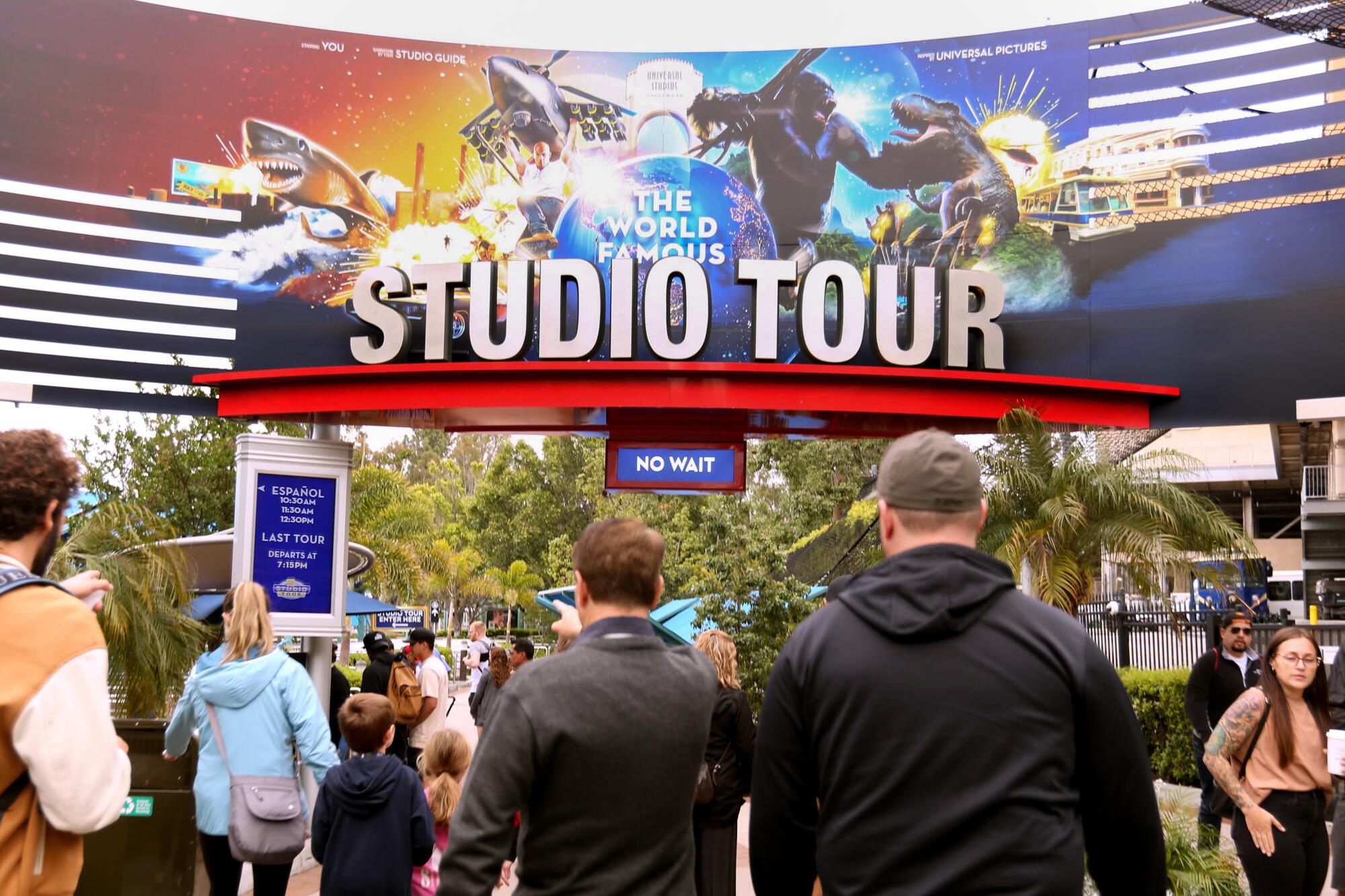
The Studio Tour is arguably the most important theme park attraction ever created. And remarkably, it earned that feat by being built in and around existing structures — and largely because Stein had two early revelations.
The first: A lack of control wasn’t going to cut it. “It was an industrial tour, and people always expected to see an actor or a production, and we couldn’t deliver on that,” Stein says. And even when they could, the latter two could be unpredictable. “When we park the tram 50 yards from a production, some of the shows that were taking place would say, ‘If we see a tram, we’re off the set. We’re gone.’” And as Gennawey notes, actor Shirley MacLaine is said to have once mooned a tram. “She kept her word,” Stein says today. “She said, ‘If I see another tram come by ... ‘“
The second: Studios are, well, kind of dull. A recent Studio Tour expressed as much, noting that the current labor strife in Hollywood has brought the studio’s backlot to a halt. “When a production was not there,” Stein says, “it looked dead, dusty and boring.”
The solution was clear: If the Studio Tour was going to be built to last, what started as a very real peek at how Hollywood worked would suddenly have to take after the industry it sought to glorify. That is, it would need to become a series of illusions.
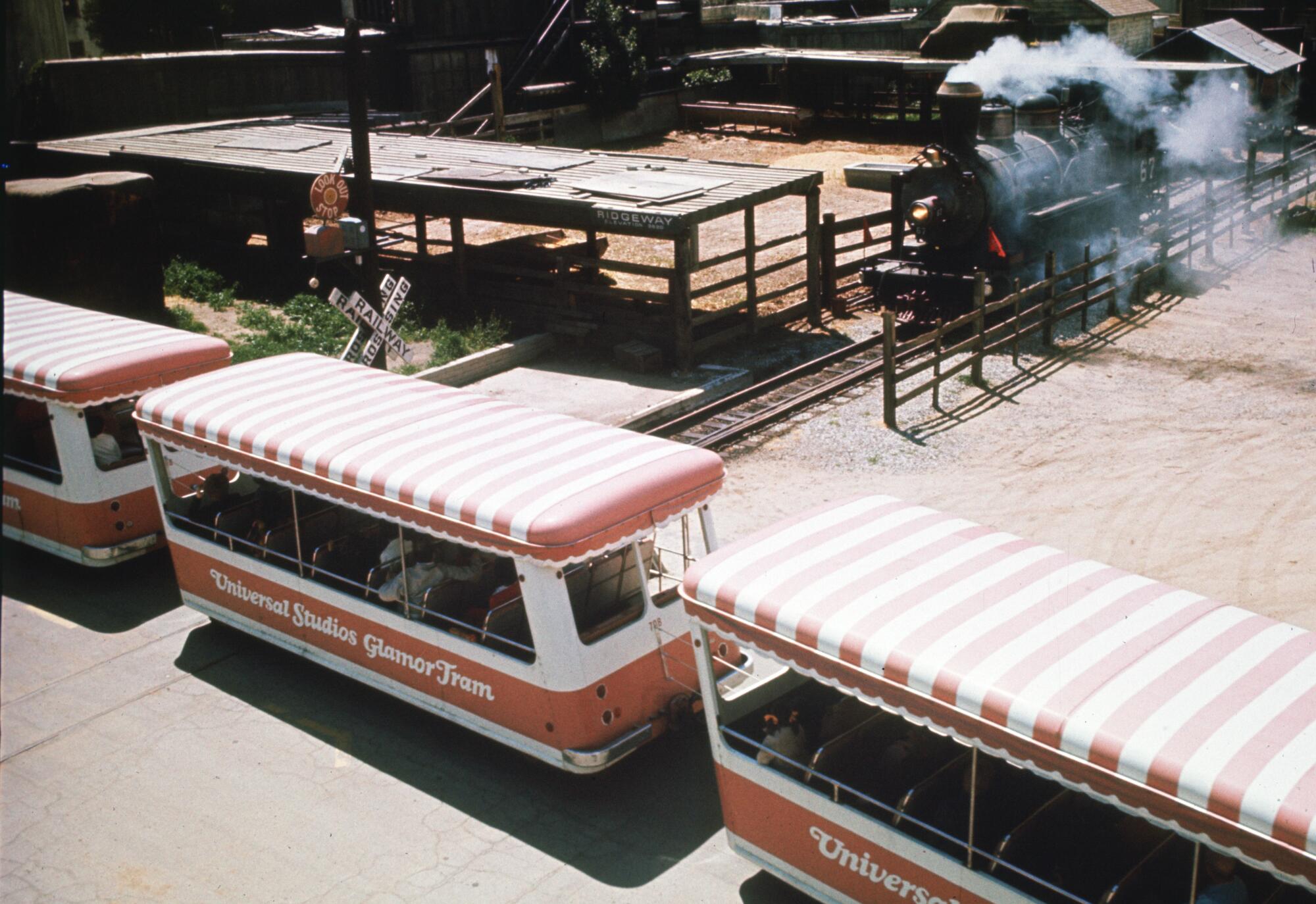
Those who have studied the current Studio Tour like to point out that it’s not the first time Universal opened its gates to become a public showplace. Universal pictures founder Carl Laemmle welcomed fans in 1915 to watch how silent pictures were made. “He charged 25 cents, and they got a box lunch in the deal,” says John Murdy, known today as the architect of Halloween Horror Nights at Universal Studios Hollywood. Murdy, who started at Universal as a tram tour guide before graduating to theme park design, has become something of a Universal historian.
“They erected bleachers so they could watch these outdoor filming stages,” Murdy says. “And there was a zoo on the property at the time, so they could tour the zoo. That went on until the late 1920s and the early 1930s, until sound came in.”
But different eras bring different financial motivations. The modern Studio Tour is rooted in a more basic human desire: We need to eat.
In the early 1960s, according to Stephen M. Silverman’s book “The Amusement Park,” Universal began welcoming Gray Line Tours onto the studio lot for their Hollywood history jaunts. The primary goal was to boost the bottom line of the studio commissary, where Gray Line guests would stop for lunch. “When they saw the commissary was making a lot of money,” says Murdy, “that was the literal seed,” and mogul Lew Wasserman allowed his staff to investigate the feasibility of running its own tour.
Universal’s tour had its grand opening on July 15, 1964, with a media rep later downplaying to The Times its goals, stating that the tour was a “public relations gesture on the part of the studio” and the aim was to simply break even. But this paper had an immediate fan in gossip columnist Hedda Hopper, who noted that tourists finally had a glimpse of Hollywood that went beyond “looking at a bunch of footprints in concrete.” Within two years, Universal was reporting that 8,000 guests per day were riding the so-called GlamorTrams, which were accentuated with candy-striped accouterments designed by Disneyland planner and famed set designer Harper Goff.
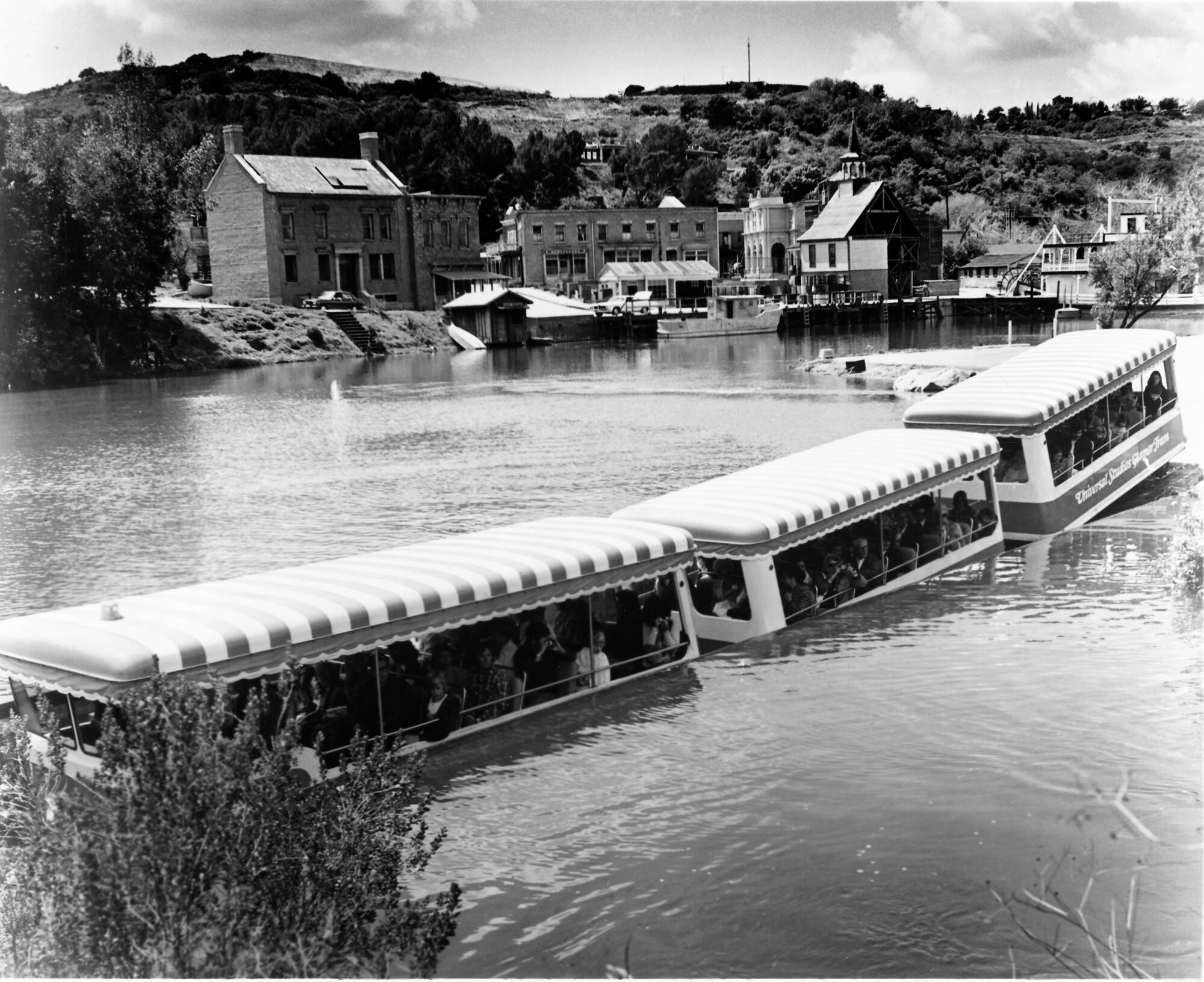
Within a year, The Times noted that Universal was experimenting with stunt shows on the tour, and by 1966 the tour was offering guests makeup demonstrations, artificial snowstorms and miniature sea battles at an upper lot concourse. Albert A. Dorskind, president of parent company MCA, soon telegraphed the studio’s ambitions, telling The Times in 1968 that he envisioned Universal becoming a Tivoli Gardens-like concept centered around entertainment, referencing the famed Copenhagen park.
Stein was the man to realize that vision, and he began experimenting around that time with a flash flood on the tram tour, in which a rush of water leaps multiple feet into the air before quickly dissipating before the tram. The flash flood is still a part of the tour today.
“The geography was there,” Stein says. “What the hell could we do with this dead-ass street and involve the audience with something other than looking at an inactive, sterile set? That’s how I came up with the flash flood. ... The problem with it, which we had no idea at that time, is in a movie you do one or two takes and throw it away. We had to build something that could be done every two or three minutes. How do you involve a tram full of people in something where you create a thrill? It was really crude and simple, and if you did something like that today it’d be like old-time movies, but that stuff was done 55 years ago and is still working because it makes a dull set exciting.”
Other illusions would follow, including a parting of the Red Sea, a collapsing bridge, an ice tunnel, a rock slide and a submarine attack — “generic stuff,” says Stein, before the tour had rights to various film and television properties. The upper lot — the second half of the tour, in which guests were allowed to freely wander — also began to expand its show offerings, creating screen tests and animal shows in addition to stunt demonstrations.
Not all of the experiments of Stein and his team, however, made the history books.
“There was one that I never understood,” Murdy says, “and I have pictures of this so I know I didn’t make it up in my child mind. There was a section by the black lagoon where they filmed some Tarzan movie. And they had a gorilla, like Tarzan, on a rope, and we’d hear the Tarzan yell but it was a gorilla. It was not Tarzan. He would swing along the side of the tram, and he was holding a severed arm in his hand. I have no idea why, but I actually have a picture. I have a picture of this from way back in the ’70s. Those were mostly done in house by the special effects teams. There wasn’t an industry yet.”
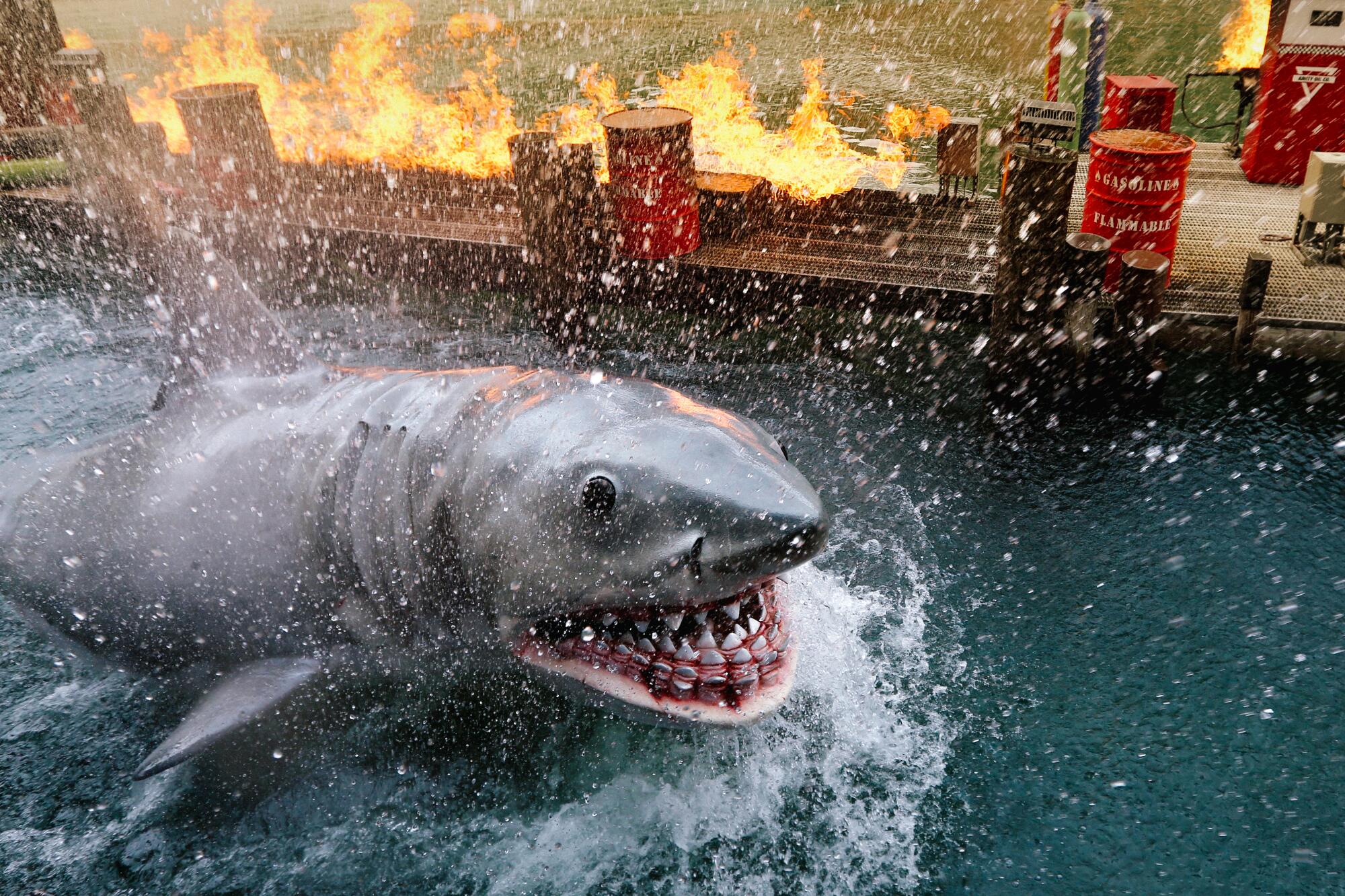
Everything changed in 1976. That was one year after Spielberg’s “Jaws” opened and when the Studio Tour built a mini re-creation of an Eastern seaboard waterfront and put guests face-to-face with a 24-foot shark. It was expensive to build and maintain, as The Times noted in 1977 that the shark required $250,000 per year in maintenance. Stein says the company even sought the help of submarine builders General Dynamics to understand how to create things to last in water.
“Jaws” forever changed the tenor of the tour, and arguably theme parks. While Disneyland had roots in the company’s animated fairy tales, especially in Fantasyland, and early attractions took cues from the studio’s “True-Life Adventures” and films such as “Swiss Family Robinson,” nothing on the level of the cultural phenomenon that was “Jaws” had so quickly been replicated in a theme park before. It’s an industry-wide trend that hasn’t stopped.
“With the addition of a ‘Jaws’ experience, guests were brought face to face with an angry shark as well as fire and water explosions, and for the first time immersed in an experience based on a blockbuster movie property,” says Phil Hettema, who runs a namesake themed-entertainment firm in Pasadena and is a veteran of Universal Creative and the Studio Tour.
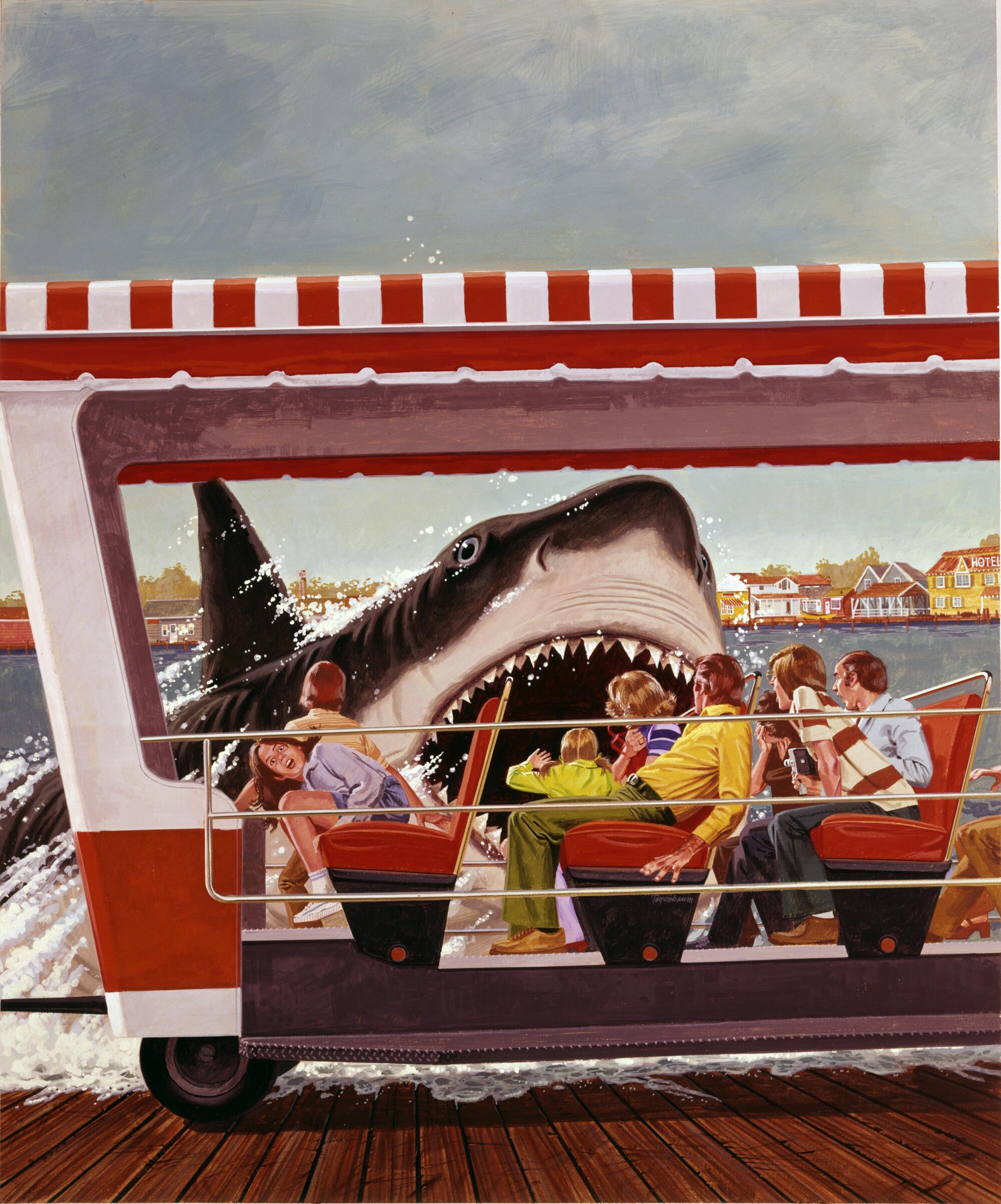
There’s gleeful pride in Stein’s voice when recollecting the “Jaws” scenes, especially in their grown-up weirdness. One moment, for instance, has the shark attacking a stationary diver and the lagoon filling with fake blood. “That’s the stuff that works,” Stein says. “The blood. By adding things that enhance the effect, that is what puts a ride over the top. No one expects when the shark is coming up that we’re going to drop the tram a foot toward the water. That scares the hell out of you. That’s what I lived for, to make this thing come alive.”
Stein and Universal were then emboldened to bring in nods to other properties, and by 1977 the tour was bringing in $25 million in revenue. “Battlestar Galactica,” “Conan the Barbarian,” “The Incredible Hulk” and more were soon added to the tour and its upper lot attractions. While the expansive theme park attraction E.T. Adventure, in which guests would simulate riding flying bikes through a darkened show building, wouldn’t come to Universal Studios Hollywood until 1991, Murdy says the beginnings of the theme park were well solidified.
“Battlestar Galactica was kind of the first big theme park-style attraction that was incorporated into the tour,” he says. “You pulled into a show venue and with live actors and animatronics the scene played out. And lasers. It was impressive. They were really shooting laser beams.”
Not everything needed to be so intense. The Hulk experience, for instance, was relatively simple, with the muscled green man simply appearing at unexpected moments — crashing, The Times reported, a makeup show, or careening through a fake stone wall at other points on the tour. “That’s a show that I think we spent $50,000 on the whole thing,” Stein says. “It’s a muscle man painted green. We got a huge bump in attendance because ‘The Incredible Hulk’ was seen by millions of people. It was no more than a guy busting through a wall. I never came up with something that was so inexpensive that was so effective.”
So much so that Universal — and those who visited its parks — began dreaming big.
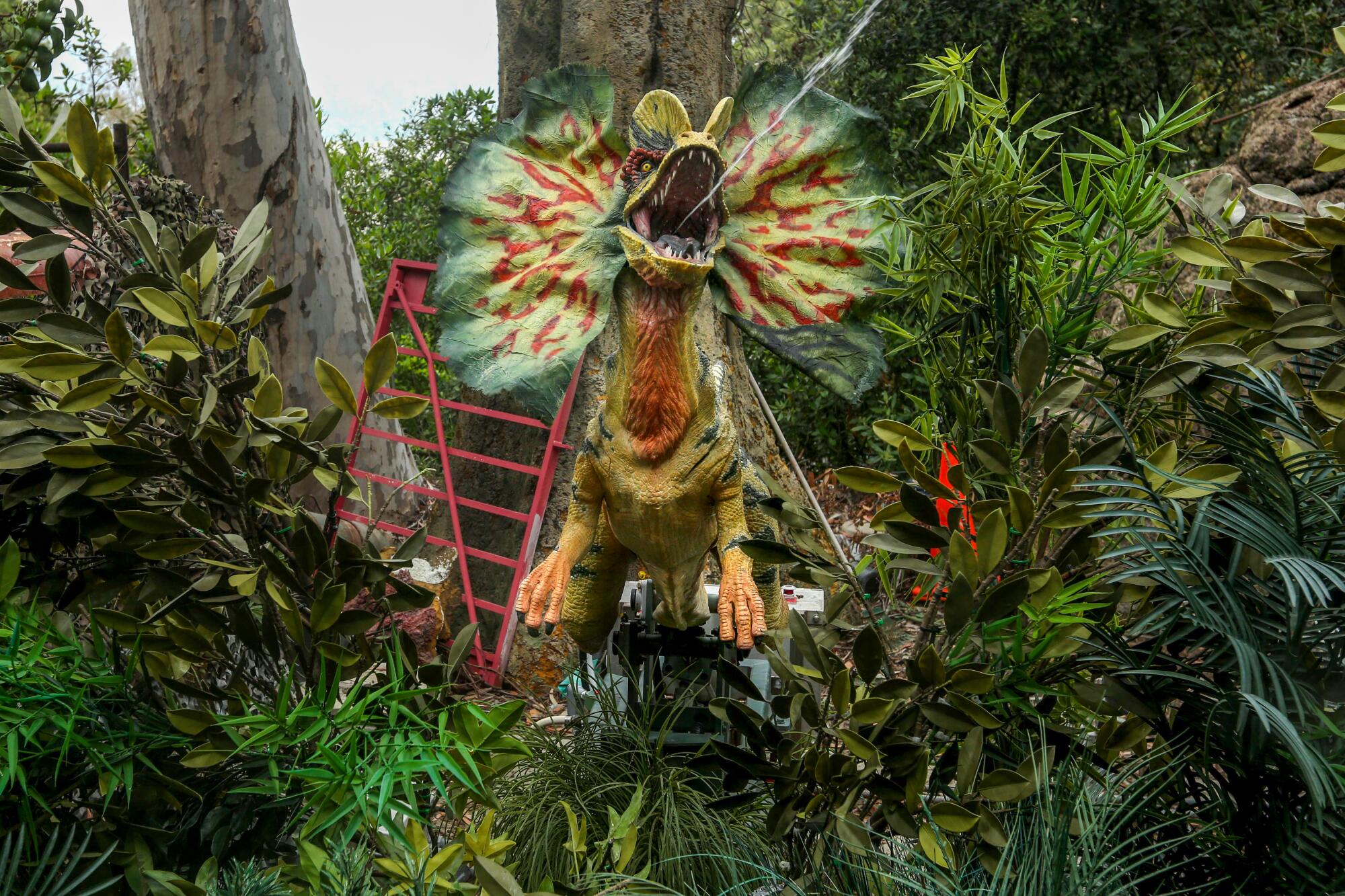
When “Nope” filmmaker Jordan Peele first made it to a Universal Studios park in Florida, it fueled, he says, a lifelong obsession.
“It was something very aspirational and magical,” Peele says. “I was told we didn’t have enough money to go to Disneyland or Universal, and at some point we got an opportunity because my mother’s job was doing something in Florida. I remember going to both places, and Universal Studios in Orlando, I remember it creating more magic for me than the other park.
“I went to very few amusement parks growing up, so when I got to Universal at 11 or 12 years old, it was formative in reinforcing my love of film,” Peele says. “It had a ‘Willy Wonka’ aspect of a world that had been opened to me that now I could sort of see behind the wall of it. Even though a lot of it is illusion, the illusion of getting to be in the presence of what it means to make movies was an addiction I never got over.”
The ’80s was a period of growth for the Hollywood Studio Tour, never more so than via the additions of a 30-foot tall King Kong animatronic that was added in 1986 (and destroyed in a 2008 fire) and an earthquake simulation in 1989, the latter of which pushed attendance to more than 30,000 people a day.
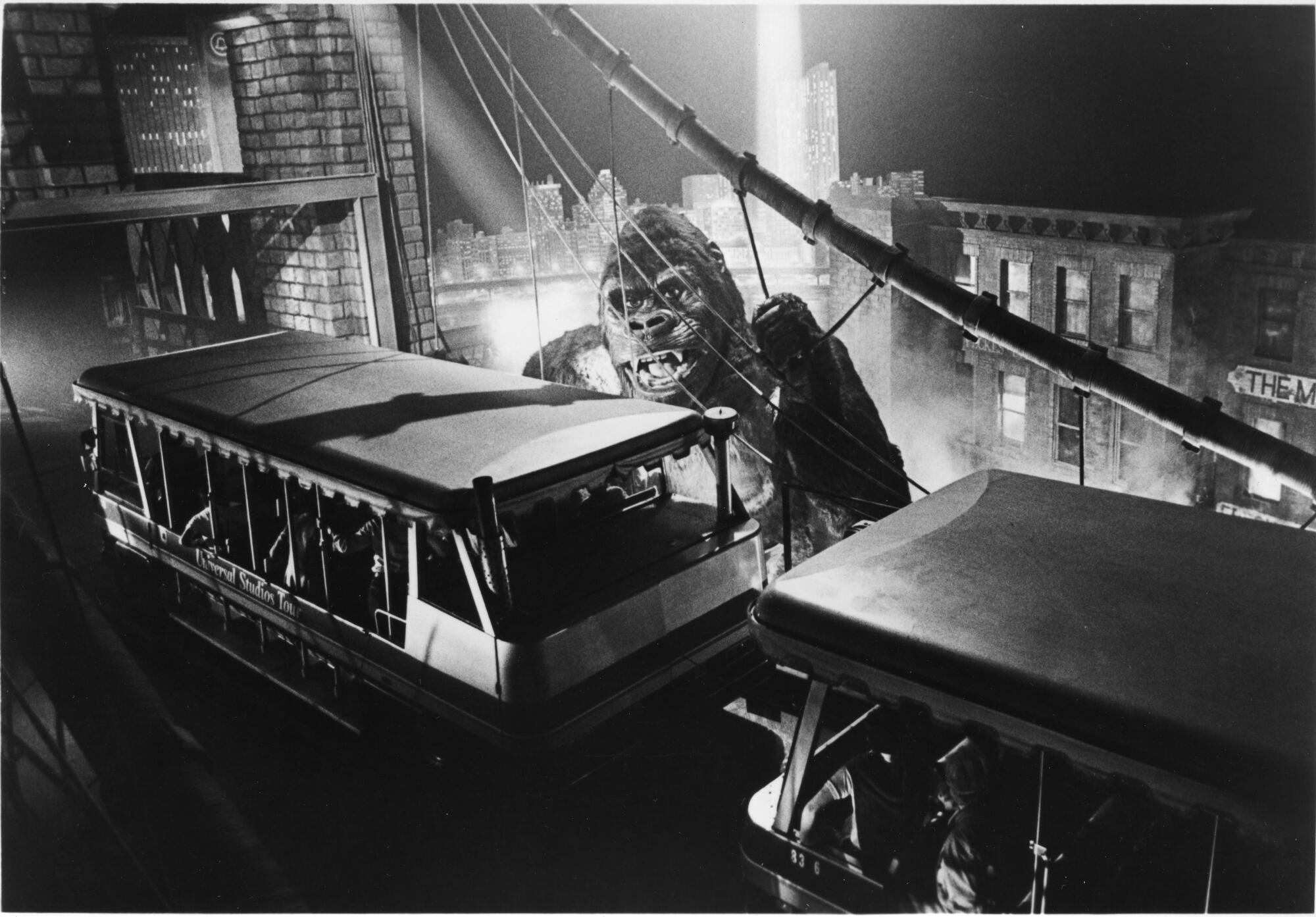
“Starting with ‘King Kong,’ guests found themselves on the tram in the midst of a completely immersive environment with a larger-than-life animated ape,” Hettema says. “Not only was the environment impressive, but, significantly, the tram vehicle itself rocked from side to side and slid across the roadway — physically engaging the guests.
“It was a hit with guests that continued with ‘Earthquake,’ where the total immersion of guests on the tram was taken to new heights — putting the guests in an illusion of danger and thrill that was visceral by physically shaking, sliding and dropping the tram. The tram could be considered the first motion base vehicle, now a key component of the most popular immersive attractions throughout the industry.”
The decade, however, was also a period of great stress for Stein. Buoyed by the success of the increased theme parkification of the Studio Tour, Universal began to look at expansion into Florida, resulting in the park that would eventually catch Peele’s heart. But when Universal Studios Florida opened in 1990, it did so after nearly a decade-long battle with the Walt Disney Co.
It’s a well-documented, often-told tale, and one that’s too large for this story to encompass, but Universal wasn’t shy in alleging that Disney stole its Florida plans for the park that would today be known as Disney’s Hollywood Studios. The latter opened in 1989 with, for instance, a tram tour that was very much in the Universal model. While Disney has long denied the contentions of Universal and its then-parent, MCA, Stein didn’t hold back, telling The Times in 1989 that “Disney took what we had, and we had to fish or cut bait,” explaining that Universal shifted from a tram-focused park to one based instead on stand-alone attractions.
Today, the subject still gets Stein worked up, and his colorful descriptions of Disney are not fit for print. “They did the same thing, and we had to up our game,” Stein says today. “If anything pissed me off more in life than that, I don’t know what it is. We knew what they were going to do. They were going to do what we wanted to do, so we upped our game in every show, every set, every stage, every element.”
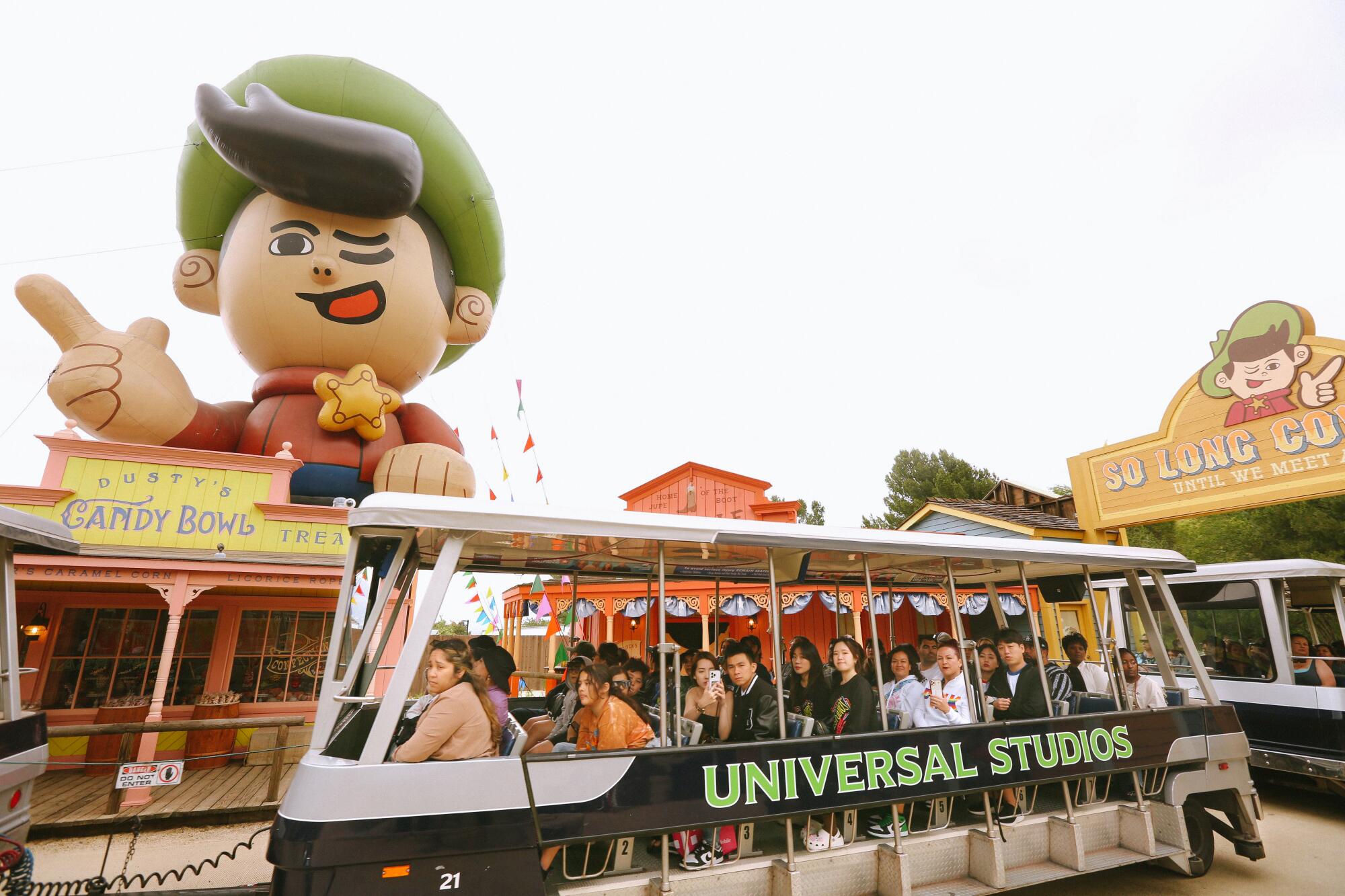
The Florida project benefited the original Studio Tour and park. The earthquake attraction was duplicated, albeit in different formats, on each coast, and remains one of the most elaborate — and frightening — attractions on the West Coast. Additionally, the park’s relationship with Spielberg would tighten. Although an E.T. attraction no longer exists in Hollywood, it’s still alive in Florida, and Spielberg’s “Jurassic Park” franchise is not only a part of the Studio Tour but received a stand-alone, water-based attraction.
When it came to competing with Disney, Stein says, Spielberg brought a level of respectability to the Universal parks. “The opportunity to get Spielberg as a creative consultant gave us a credibility,” Stein says. “Nobody had heard of Jay Stein, but that was as much a contributory factory to our success as anything. He delivered the goods.”
“Movies bring us together from all walks of life to hear good stories,” Spielberg wrote via email. “Many of these stories are themed and can make deep and lasting impressions. Theme parks, like Universal’s, bring the memories of these stories into three dimensional life. In 1989 when I coined the term ‘ride the movies,’ it still stands as one of the main reasons people descend on our theme parks to be part of those stories in a real world way.”
The Studio Tour remains the backbone of the Universal theme parks, the impetus for its expansion and the home to relatively constant renovations.
Last year, the Studio Tour took in the set of the fictional Gold Rush-themed amusement park of Jupiter’s Claim from “Nope.” It was Peele who reached out to the theme park and asked if it might be interested in the set. “That’s right,” Peele says. “If you can’t tell from my personality or my films, I’m very into memorabilia and objects and cars and sets from films. It’s very hard when a film is done to take something [down] that I believe is something that people will want to experience in the future.”
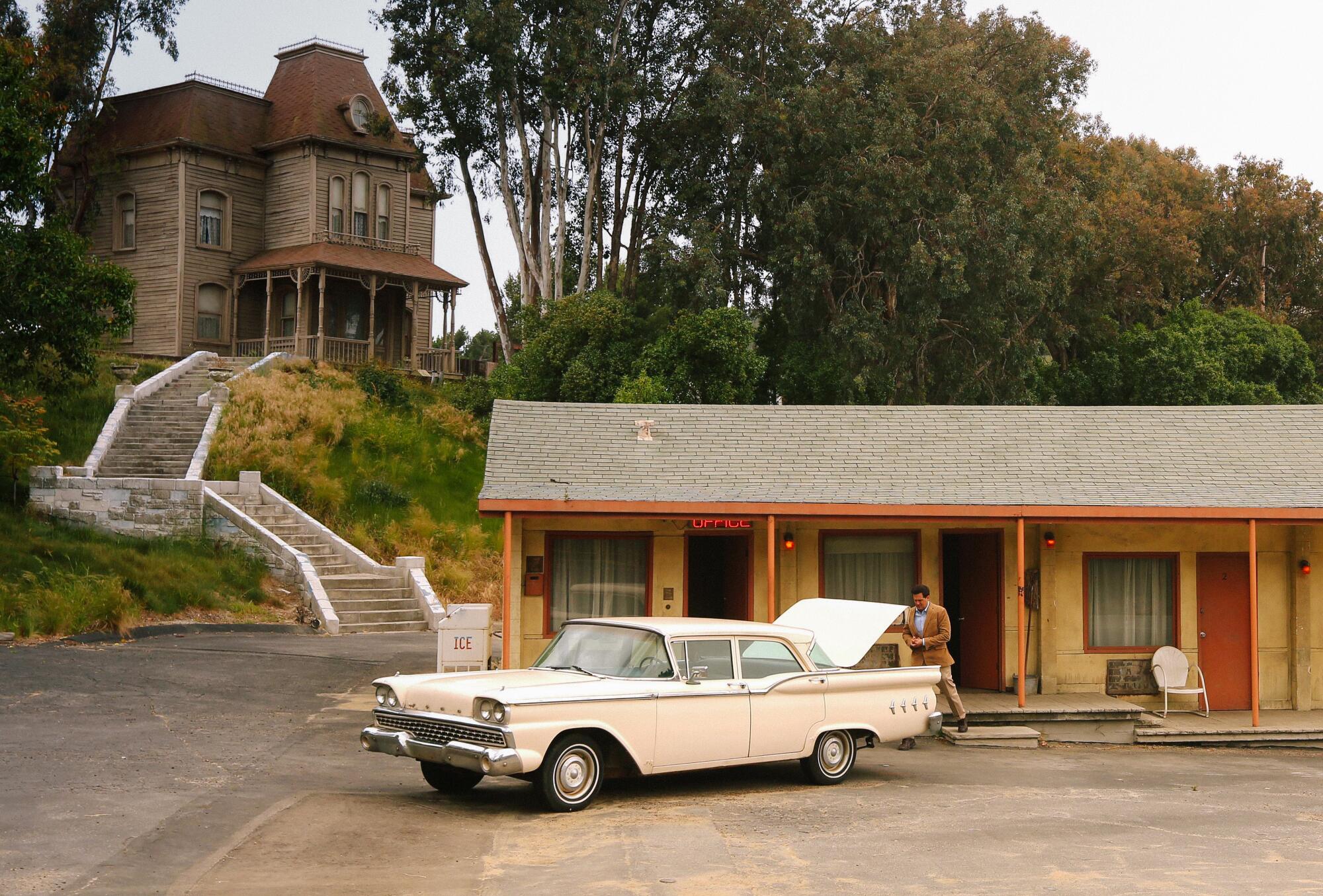
That it’s part of the Studio Tour, Peele says, has helped cure some of his impostor syndrome. “Steven Spielberg and Alfred Hitchcock, these were figures that helped inspire me to not compromise in the commitment to the bigness of the audience’s experience,” Peele says. “So for a piece of [‘Nope’] to end up among ‘Jaws’ and ‘Psycho’ on this tram tour, you can see how a kid who felt like he was an impostor for even stepping into the gates, it’s a full circle sense of accomplishment. ... Believe me, I have some humility, but the character of making that film was not humble. It was meant to be a film that people would want to be on the set. Let’s presume ourselves next to ‘Jaws.’”
Productions once tried to hide from the Studio Tour; today, they ask to be a part of it. The Studio Tour, in execution and in reputation, is a long way removed from attempting to scare guests with the rubber boulders of a fake rock-slide, all in an effort to increase lunch sales.
“There was enough pressure that could have been brought to kill this thing,” Stein says of the tour’s mid-’60s beginnings. “Because who needs this interruption on a daily basis so you can have a small profit at the end of the year? The commissary was losing money, so the tourists would be allowed to eat at 3 p.m. in the commissary. It was small potatoes and not anything that would have shown at that time any indication that it was going to have the growth potential that I ultimately saw. It reinvigorated me.
“This little thing,” Stein continues, “had the potential to be very special.”
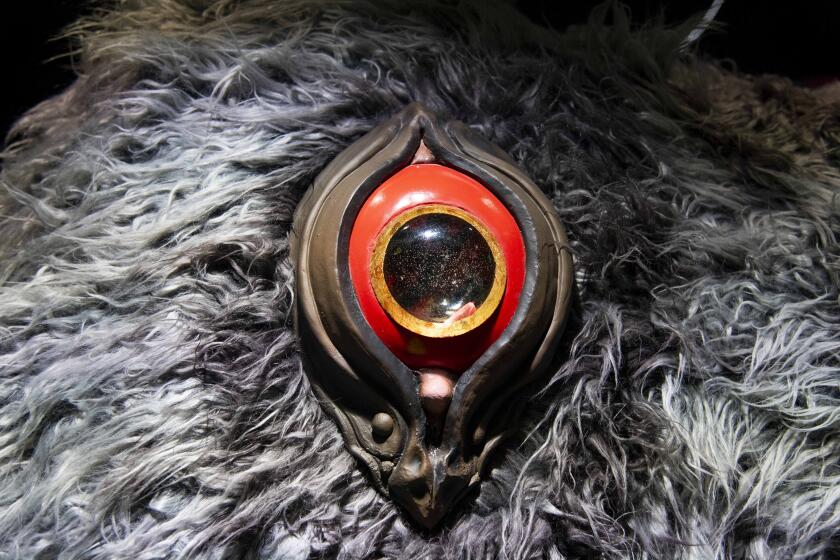
Entertainment & Arts
Meow Wolf is ready for Texas. Is Texas ready for Meow Wolf?
A first look at Meow Wolf’s latest wonderland in Texas, which plants the company’s progressive flag in a red state with a message that art can break barriers.
July 6, 2023
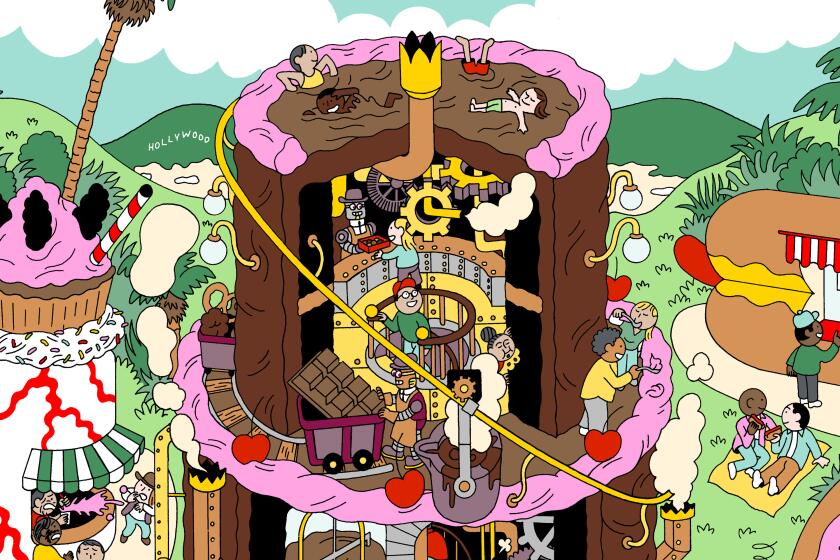
Does this new robot-staffed chocolate emporium signal a themed restaurant comeback?
Dinner with a robot assist? Toothsome Chocolate Emporium at Universal Studios’ CityWalk is a popular weekend reservation. Will it revive themed restaurants?
March 2, 2023
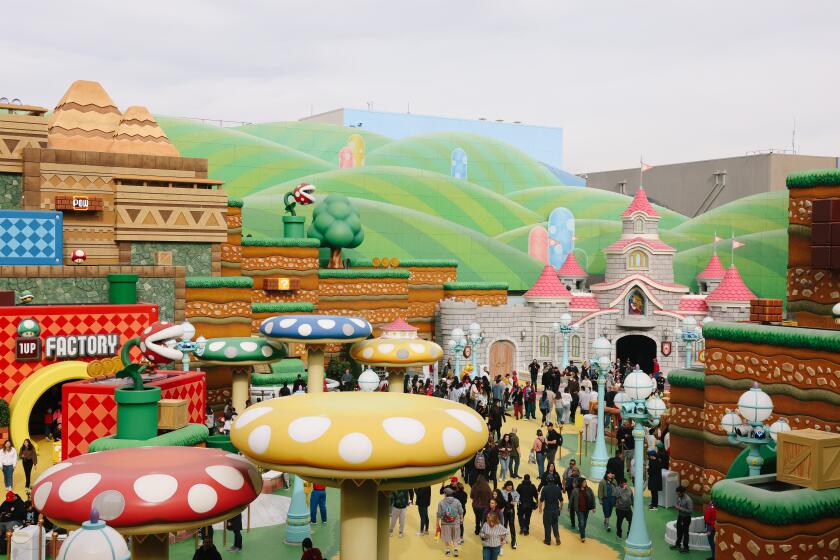
Universal’s Super Nintendo World is the play-focused theme park land for our times
‘Super Mario Bros.’ creator Shigeru Miyamoto on the importance of play: A visit with the game design mastermind at Universal Studios’ Super Nintendo World.
Feb. 23, 2023
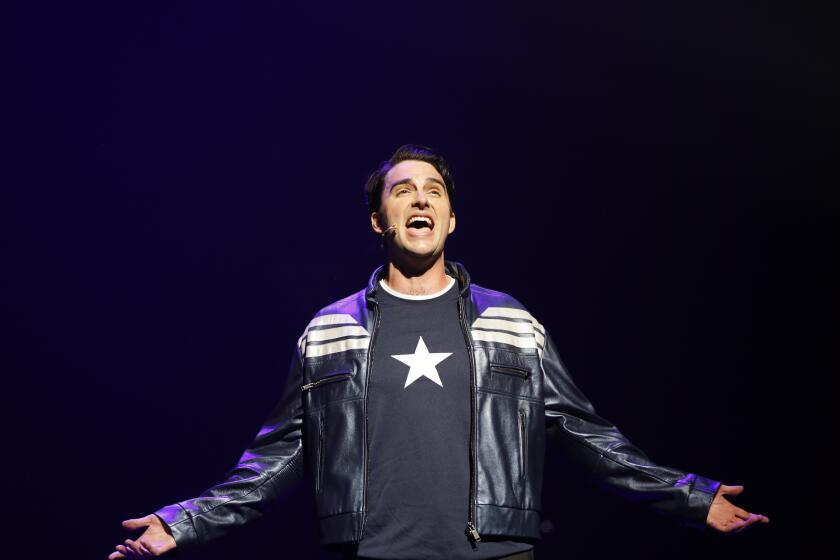
‘Rogers: The Musical’ brings a charming, Broadway-style show back to Disney California Adventure
‘Rogers: The Musical,’ Disney’s new Captain America-inspired musical, started as a joke in a Disney+ series and now is part of the resort’s big summer offerings.
June 30, 2023
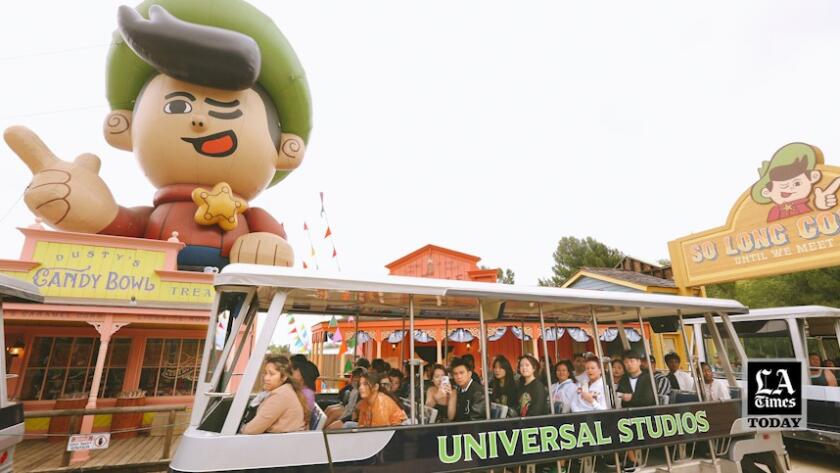
Watch L.A. Times Today at 7 p.m. on Spectrum News 1 on Channel 1 or live stream on the Spectrum News App. Palos Verdes Peninsula and Orange County viewers can watch on Cox Systems on channel 99.
More to Read

Universal Studios tram riders were seriously injured in crash, lawyer says
April 24, 2024

Why Disney is doubling down on theme parks with a $60-billion plan

Universal Studios tram tossed “multiple” riders to the ground, accident investigators say
April 22, 2024
The biggest entertainment stories
Get our big stories about Hollywood, film, television, music, arts, culture and more right in your inbox as soon as they publish.
You may occasionally receive promotional content from the Los Angeles Times.

Todd Martens joined the Los Angeles Times in 2007 and covers a mix of interactive entertainment (video games) and pop music. Previously, Martens reported on the music business for Billboard Magazine. He has contributed to numerous books, including “The Big Lebowski: An Illustrated, Annotated History of the Greatest Cult Film of All Time.” He continues to torture himself by rooting for the Chicago Cubs and, while he likes dogs, he is more of a cat person.
More From the Los Angeles Times

May the 4th be with you! Here’s everything our critics have said about the ‘Star Wars’ franchise
May 2, 2024

Travel & Experiences
Zip, zoom and soar in L.A.’s extraordinary new playground for bike riders
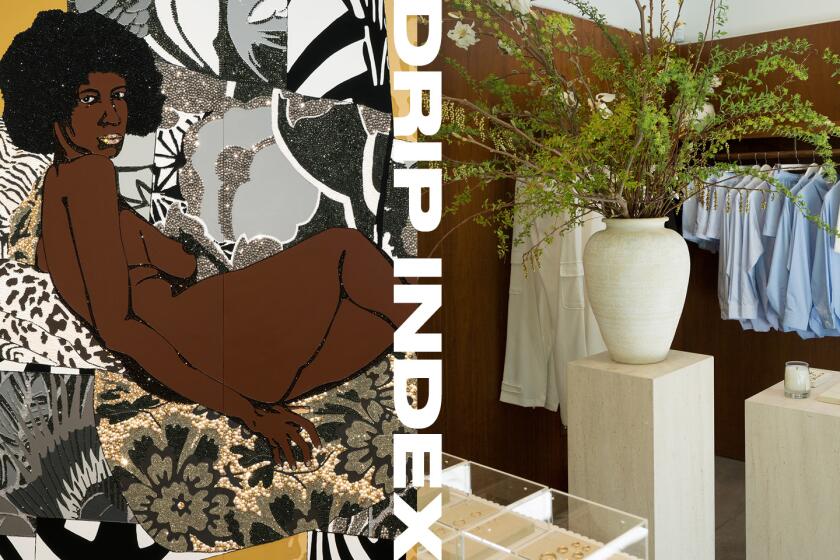
8 L.A. happenings in May to get you ready for summer
April 30, 2024

27 very L.A. ways to spend time with Mom — or not — on Mother’s Day

Universal Studios Hollywood Studio Tour celebrates its 60th anniversary
I first visited Universal Studios Hollywood in 1980, and couldn’t wait to take their Behind-the-Scenes Studio Tour . Flash forward 44 years (gosh I’m old), and now the Universal Studios Hollywood’s Behind-the-Scenes Studio Tour 60th anniversary is here. The iconic attraction was the genesis of Universal Studios Hollywood and set the stage for the development of Universal Studios theme parks and resorts around the world.
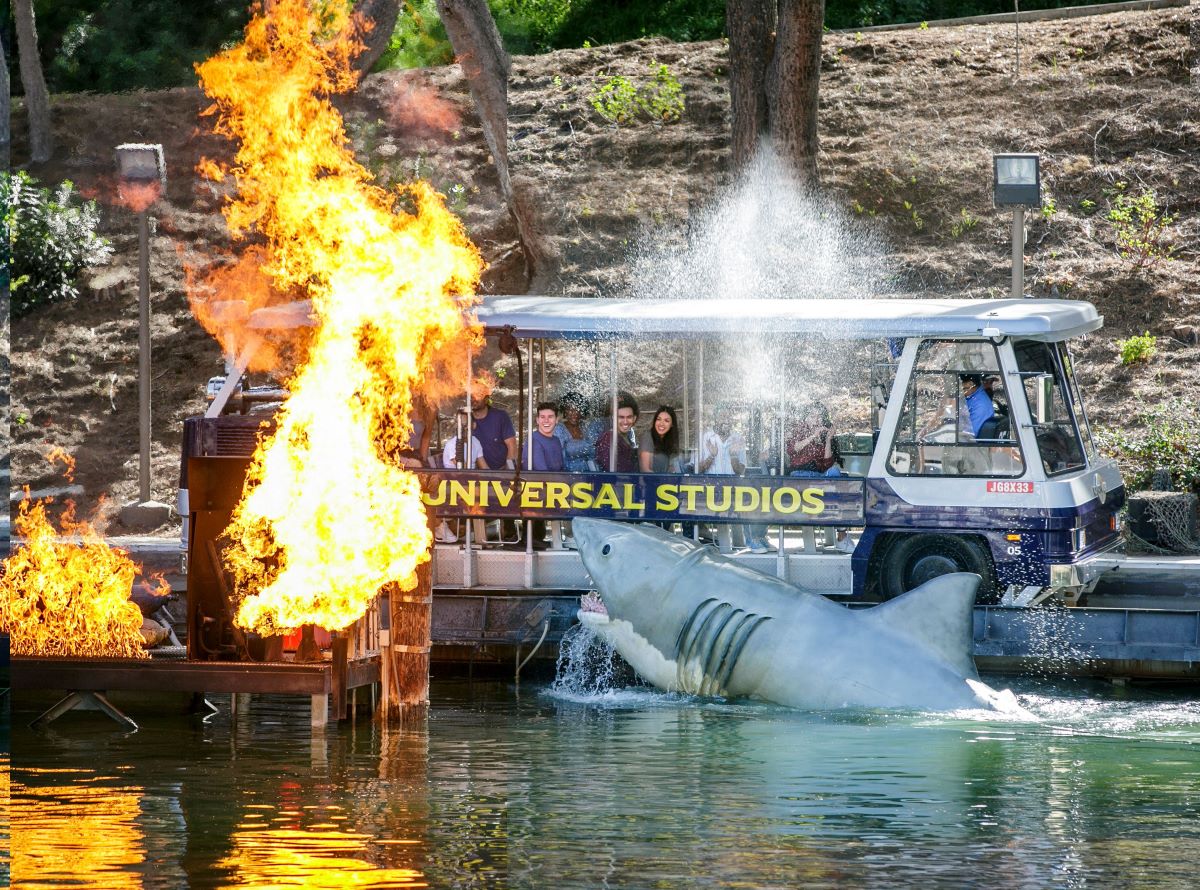
When I visited with my family in 1980, I snapped photos of the 18-wheeler truck from “B.J. and the Bear” and Cylons from “Battlestar Galactica,” saw the “Psycho” house, and drove through a parted Red Sea. But there was one thing that overshadowed my whole experience – the “Jaws” shark. It was five years since “Jaws” terrorized the big screen, and still traumatized by the apex predator, I constantly switched sides of the tram to avoid facing the shark directly.
The Debut of the Studio Tour
In 1964, Universal Studios Hollywood (originally referred to as Universal City Studios) rolled out its fleet of Glamor Trams, inviting tourists to “see film rushes of current productions, both feature and television, being made at Universal City,” according to the attraction’s original press release issued on July 4, 1964.
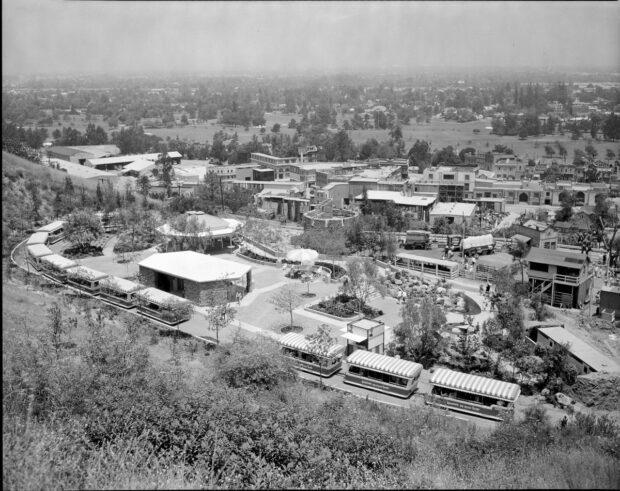
It was a novel concept to invite the public to be a “fly on the wall” of movie and television production. After all, no one else had ever conceived of the idea. The iconic red and white Glamor Trams, with their ruffled awnings, were staged five times a day Monday through Friday, with each tour lasting just over two hours.

The point of entry for visiting guests at that time was at The Tourist Center, located at the Universal Commissary Building, where make-up artist demonstrations, trick photography, and special props were on display. That was 60 years ago, and while much has transpired over the years aspects of the original Glamor Tram tour have remained constant over this astonishing six-decade span (although the trams themselves were converted to environmentally friendly electric ).

Tour Guides
Universal Studio Tour Guides have always been central to the operations of the Glamor Tram tours, and the role of Studio Tour Guide is a coveted position with candidates auditioning from around the world.
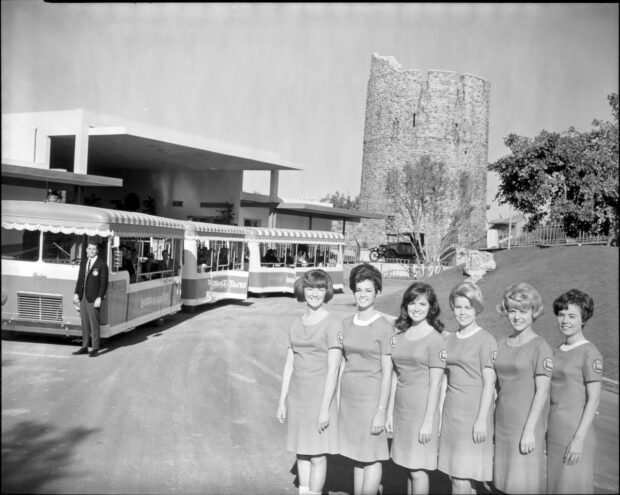
Now considered a Hollywood “apprenticeship,” future filmmakers, budding actors and executives in-the-making are empowered to take advantage of a variety of opportunities and Hollywood-insider perks including free acting classes, participating in a showcase for casting directors, job placement opportunities, and more. Dozens of producers, directors, performers, movie and TV professionals as well as industry executives began their careers as Studio Tour Guides. You might even glimpse comedian Jimmy Fallon on tour .
60 Years of the Universal Studio Tour
Over the past 60 years, the Studio Tour has received many updates, additions, and changes. For a walk down memory lane, here’s look back at some of the many milestones that shaped the seminal attraction:
In 1964, guests were ushered past iconic sets from Alfred Hitchcock’s renowned film “Psycho” directed by Alfred Hitchcock – one of the very first film sets accessible for visitors to see up close and personal (the “Psycho” hotel and nearby Bates Motel are still featured on the tour today).

Bygone, nostalgic Studio Tour attractions included the Parting of the Red Sea (1973), which demonstrated an early special effect technique, and the spinning Ice Tunnel (1975) which showed the effects of a severe snowstorm and forced perspective, as well as a dynamic hillside rockslide of tumbling faux boulders and a near miss collision with the infamous Runaway Train.

In 1971, Flash Flood showered guests with a unique behind-the-scenes look at movie weather effects. All these years later, the popular attraction continues to be a staple on the Studio Tour.
“Jaws Lake” took a bite out of the studio backlot in 1976, a year after Academy Award-winning filmmaker Steven Spielberg’s movie debuted, which has withstood the test of time as one of today’s premier Studio Tour attractions.

In 1989, “Earthquake” had guests clinging for their lives with its fabricated but eerily realistic 8.3 magnitude quake. All these years later, “Earthquake,” which continues to shake things up on the Studio Tour, will debut anew with updated and contemporary technology and aesthetics.
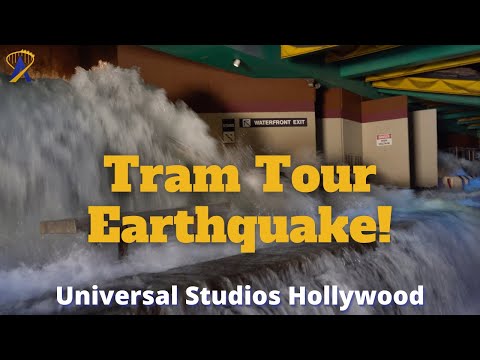
In 2005, an original movie set from Steven Spielberg’s blockbuster, “War of the Worlds” landed onto the backlot as a sprawling addition to the Studio Tour, in which trams traverse a key scene depicting a small town devastated by an elaborately choreographed 747 jetliner crash and surrounded by wreckage and debris.

When the 1986 King Kong attraction was destroyed in the 2008 backlot fire, the behemoth primate reemerged in 2010 as “King Kong 360-3D,” a signature attraction on the Studio Tour, inspired by filmmaker Peter Jackson’s Oscar-winning film.
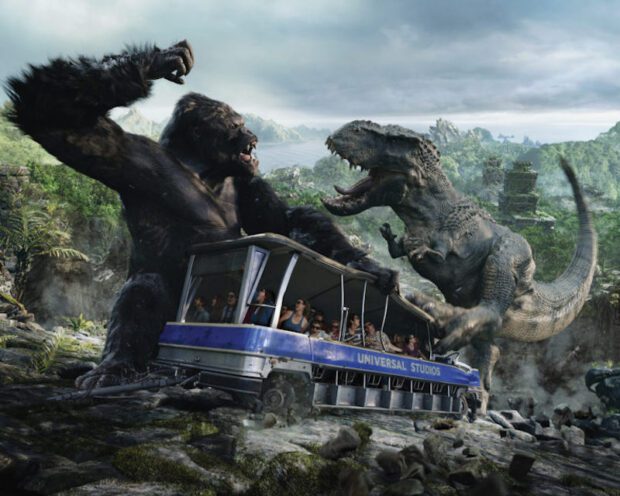
The original Jupiter’s Claim set from Jordan Peele’s expansive horror epic, “ Nope,” became the latest addition to the Studio Tour in 2022 . The elaborate set was carefully disassembled post-production and transported to Universal Studios Hollywood where it was meticulously reconstructed on-site, complete with original props and details from the film for Universal Studio Tour fans to enjoy.
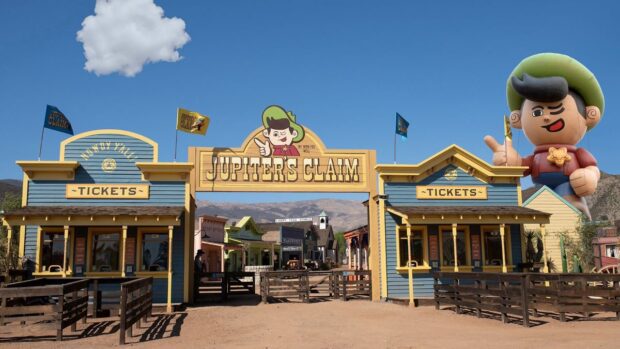
What’s Next for the Universal Studio Tour?
The Studio Tour of today continues to build on its rich history and like many great blockbuster films, creates a foundation for the next big sequel… and therein lies the origins of Universal Studios Hollywood.
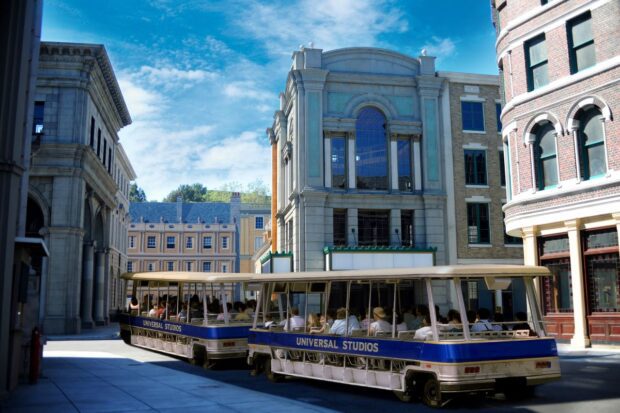
2024 celebrates the Universal Studio Tour 60th anniversary, the more than 200 million guests who have experienced this attraction and, ultimately, Universal Studios Hollywood’s storied history. More information will be shared soon highlighting the program planned for the Studio Tour’s 60th anniversary.
Click here for more information about the Universal Studio Tour.


Leave a Reply Cancel reply
Your email address will not be published. Required fields are marked *
Sign me up for the Attractions Magazine e-mail newsletter!
The Definitive Voice of Entertainment News
Subscribe for full access to The Hollywood Reporter
site categories
Hollywood flashback: universal’s theme park debuted its studio tour in 1964.
Universal Studios Hollywood — which reopens April 16 after a year of lockdown due to COVID-19 — has had brushes with disasters before, including nine fires since 1932.
By Seth Abramovitch
Seth Abramovitch
Senior Writer
- Share this article on Facebook
- Share this article on Twitter
- Share this article on Flipboard
- Share this article on Email
- Show additional share options
- Share this article on Linkedin
- Share this article on Pinit
- Share this article on Reddit
- Share this article on Tumblr
- Share this article on Whatsapp
- Share this article on Print
- Share this article on Comment

When Universal Studios Hollywood reopens April 16, emerging from a year lost to COVID-19, it won’t have been the studio and theme park’s first brush with disaster. The place has endured nine fires since 1932, the worst in 2008 — a three-alarm blaze that destroyed sets like the New York Street and the King Kong attraction as well as “the video vault,” which contained more than 100,000 priceless master tapes from artists like Chuck Berry and Nirvana.
After a brief closure, the park reopened, and attendance has crept up steadily — from 4.3 million in 2009 to 9.1 million in 2018. Almost from its inception, Universal Studios was open to the public. In 1915, founder Carl Laemmle charged visitors a nickel to tour the new studio, which sat on 400 acres of San Fernando Valley farmland. The fee included a boxed lunch. By the 1930s, the tour was discontinued because the studio was making talkies and the visitors were too noisy.
Related Stories
Verizon loses 64,000 tv subs in fourth quarter, adds broadband users, restart berlin: how germany's film and tv industry got back to work.
The current theme park has its origins in 1962, when Music Corporation of America (MCA) bought out the studio and then-president Albert Dorskind saw revenue potential in allowing Gray Line tour buses on to the lot. By 1964, Dorskind convinced MCA chairman Lew Wasserman to invest $4 million ($34 million today) into constructing trams and dedicated tour facilities. The pink-and-white-striped GlamorTrams debuted July 15, 1964, and took visitors on a tour that included a walk-through of Doris Day’s dressing room and a Western shootout performed by two stuntmen.
The attractions grew more ambitious over the years: In 1968, a flash flood engulfed the trams; in 1972, the Parting of the Red Sea was added; in 1976, the Jaws Experience was unveiled, featuring a 25-foot-long mechanical shark; and in 1986, a 30-foot-tall, animatronic King Kong, modeled after the Kong from the 1976 Jessica Lange movie, thumped his chest for the first time. In 2010, instead of laying him to rest, the park gave him a post-fire face-lift — with Peter Jackson’s King Kong.
This story first appeared in the April 14 issue of The Hollywood Reporter magazine. Click here to subscribe.
THR Newsletters
Sign up for THR news straight to your inbox every day
More from The Hollywood Reporter
Billie eilish’s ‘hit me hard and soft’ tour kicks off in october — where to buy tickets before they sell out, where to buy the best mother’s day gift baskets and boxes online, law roach says he and zendaya are “fashion soul mates”, how to watch ‘the tattooist of auschwitz’ online, wes anderson and montblanc brought the snow to l.a. to celebrate 100 years of the meisterstück pen, matthew and camila mcconaughey play pickleball pantsless in new tequila ad.
- Food & Discovery
The Birth of the Universal Studios Tour
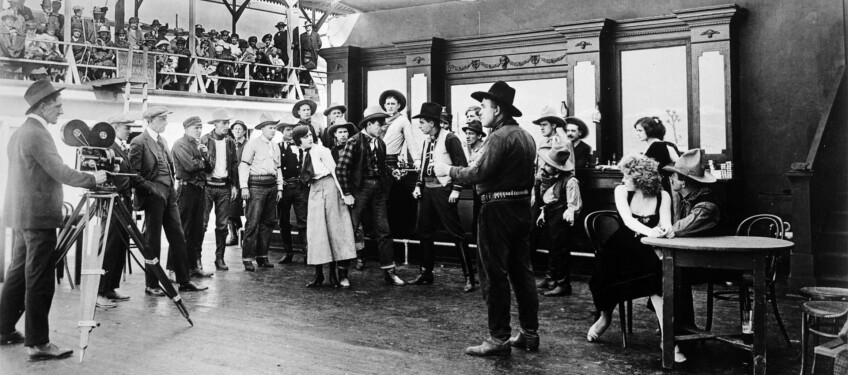
- Share on Facebook
- Share on Email
- Share on LinkedIn

By March of 1914, Carl Laemmle's Universal Film Manufacturing Company needed more land. Laemmle and his partners founded the company in the spring of 1912 in New York, merging the new venture with several already-established film production companies. The merger gave Universal the use of the Champion Film Company studio in Fort Lee, New Jersey, the film production capital of the world at the time. Already a seasoned nickelodeon owner, Laemmle recognized that producing his own films would enable him to avoid both hefty licensing fees and production regulations imposed by Thomas Edison's Motion Picture Patents Company (MPPC). Still, Fort Lee's inclement weather and Universal's ongoing legal challenges from the MPPC made New Jersey inhospitable. Laemmle, along with a handful of other film producers, fled west.
More on early Hollywood and Lost LA

How Women Built Early Hollywood – And Transformed Los Angeles
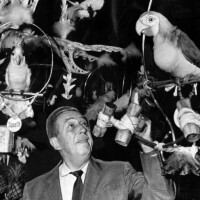
The Enchanted Nuclear Robots of Disney’s Tiki Room

Lost LA Field Notes: Fantasyland
After arriving in Los Angeles, Laemmle took control of the Nestor Film Company production facility, which delivered Hollywood’s first films. Nestor's staff churned out three pictures a week from their studio, a former tavern rented from widow Marie Blondeau. The building conveniently offered multiple rooms and spacious grounds at the corner of Hollywood and Gower, enabling several films to be shot simultaneously. When a script called for a more expansive location, Nestor’s crews shot in the San Fernando Valley on land leased from the Providencia Land and Water Development Company. However, lugging equipment and personnel on location required precious time and money. In order to increase efficiency and profits, Laemmle determined to consolidate Universal’s holdings. Laemmle decided to build the world’s first city dedicated entirely to making movies.
Laemmle purchased 230 acres of land in the valley for $165,000 and started construction. Ignoring his colleagues’ jeers, who often referred to the decision as “Laemmle’s Folly,” the burgeoning movie mogul hired hundreds of workers to realize his vision. While filming continued on the grounds, Laemmle installed sets and stages as well as a bank, post office, school and zoo. Laemmle even hired a group of Native Americans to perform in his films and live on the property in tepees. Following a year of construction, the city, with a population of almost 500 actors and stagehands, neared completion and Laemmle planned his grand opening.

In March of 1915, Laemmle spent eight days on a train traveling from Chicago to Los Angeles to drum up publicity for the official opening of Universal City. To celebrate his creation, now the largest film production facility in the world, Laemmle arranged for two days of festivities that included a parade, a western shootout culminating in a flash flood, and an air show. Thousands of spectators cheered the breathtaking spectacles on the first day. The excitement came to a tragic end on day two however, when a hired aircraft suffered a weather-related crash, killing the stunt pilot. Though Laemmle dispersed the crowds and closed the studio, he retained the notion of inviting people into his movie city.
Laemmle soon reopened Universal City to the public. Anyone with 25 cents for admission could thrill to the performances of their favorite film stars, while another nickel bought a boxed chicken lunch! Laemmle erected bleachers around the studio sets, encouraging audiences to cheer the heroes and boo the villains as the actors mugged for the cameras. Between takes, patrons could wander around the stages, collect autographs and visit the zoo, and the tour remained popular for over a decade. Then, with the advent of sound recording, which required a quiet set, the first version of the studio tour was put an end for nearly three decades.
Universal Studios, by then a division of MCA, officially opened its doors to the public again in 1964. Studio patrons purchased tickets for $2.50 and boarded a custom-designed pink and white Glamortram. The 90-minute guided tour included behind-the-scenes access to film and television production, costume exhibitions and an updated version of the western shootout and stunt show. The Glamortrams also stopped at the studio commissary halfway through the tour where, for an additional fee, guests could have lunch.
The new tram tours proved wildly popular, and MCA/Universal devoted more resources to the attraction. Universal City added a hotel to accommodate tourists, as well as a burning house, a rockslide and a collapsing bridge to the tour experience. Following the success of Steven Spielberg’s 1975 blockbuster “Jaws,” ride designers built a 25-foot mechanical shark to menace the passing tram. The tour continued to grow and evolve with new attractions and shows. Over the ensuing decades the behind-the-scenes aspect of the Glamortram tour became less important. In its place grew a theme park with rides and exhibitions devoted to movies and celebrating all things Universal.

At over 400 acres, Universal City now includes the studio’s backlot and offices, an outdoor mall with restaurants, hotels and the theme park. The flagship location of Universal Parks and Resorts, Universal Studios Hollywood hosted over nine million visitors in 2017 as ticket prices climbed to over $100 each — lunch not included. Universal operates theme parks with similar tours in Orlando, Japan and Singapore, with plans for new parks in Beijing, South Korea and Moscow. The current satellite studio tours are equally as successful as those in Hollywood, despite Universal not operating actual film studios in those locations.
Carl Laemmle envisioned a city dedicated to the movies. The studio tour, once simply a method of attracting audiences and publicity to Universal Films, transformed over time into a worldwide empire with revenues in the billions. While most early film studios are now mainly fading celluloid and memories, “Laemmle’s Folly” continues to grow in popularity, offering new generations of film lovers the chance to go behind the scenes.
Top Image: Photograph of filming a western movie on the Front Lot Stage at Universal City, ca. 1915 | California Historical Society at University of Southern California Libraries
Lost LA Field Notes: Ghost Towns

Lost LA Field Notes: Desert Fantasy

How Disneyland's Main Street, USA, Changed the Design and Preservation of American Cities

Miracles and Mirages: How Curtis Howe Springer Stole the Desert

Fantastic! — L.A.’s Architecture of Dreams
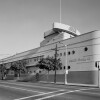
Lost LA Field Notes: Surf’s Up!

A Venice Post Office Mural Preserves the History of Abbot Kinney
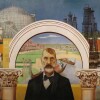
A Los Angeles Primer: Universal City

Disney’s Lost Plans to Build a Ski Resort in Sequoia National Park

How Central Casting Found "Racial Types" For Classical Hollywood Films

Zzyzx: Revisiting Doc Springer's Boulevard of Dreams

Lost LA Field Notes: Venice
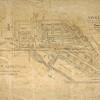
Lost LA Field Notes: What’s the Authentic Yosemite Experience?

Iconic Neighborhood Restaurants: Toluca Lake, Universal City, & Studio City
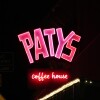
Pasadena Claims To Be The Home Of The Cheeseburger — But There's Beef

From Hiking to Hospitals: L.A. at the Center of the Pursuit of Health

Behold the Bunnies and Bonnets of L.A.'s Past Easter Celebrations

The Iconic Attraction was the Genesis of Universal Studios Hollywood and Set the Stage for the Development of Universal Destinations & Experiences Global Theme Parks
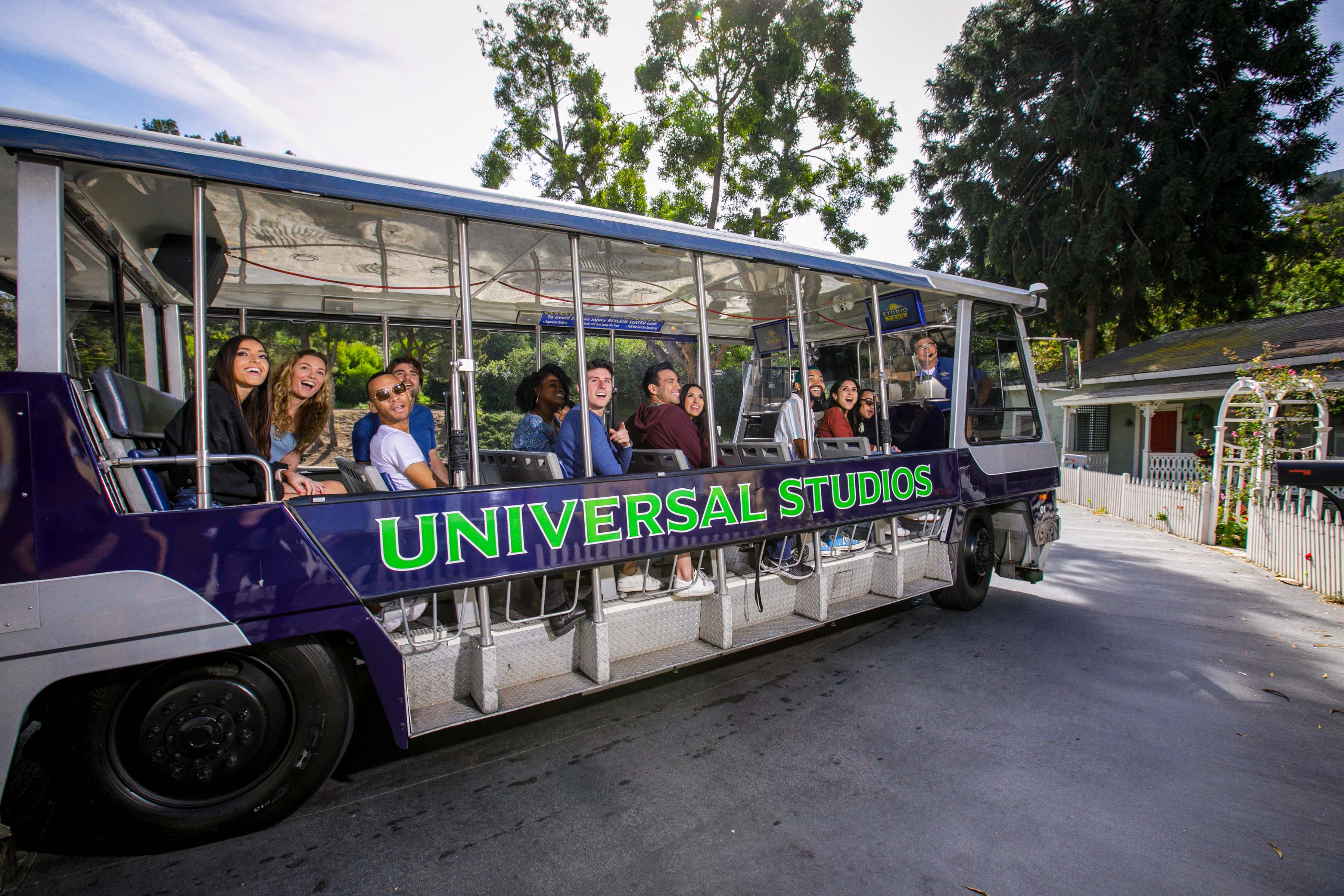
Universal City, California, January 23, 2024 – In 1964, Universal Studios Hollywood, originally referred to as Universal City Studios, rolled out its fleet of Glamor Trams, inviting tourists to “see film rushes of current productions, both feature and television, being made at Universal City,” according to the attraction’s original press release issued on July 4, 1964.
It was a novel concept to invite the public to be a fly on the wall of movie and television production. After all, no one else had ever conceived of the idea. The iconic red and white Glamor Trams, with their ruffled awnings, were staged five times a day, each lasting just over two hours, Monday through Friday.
2024 celebrates the Studio Tour’s milestone 60 years, the more than 200 million guests who have experienced this attraction and, ultimately, Universal Studios Hollywood’s storied history. More information will be shared soon highlighting the exciting program planned for spring and summer in support of the Studio Tour’s 60 th anniversary.
During its inaugural year, behind-the-scenes special effects featured a brief make-up demonstration, a display of costumes by renowned costume designer Edith Head, an energetic two-man stunt performance and a tour of picturesque outdoor film sets. The following year, Universal expanded its scope of entertainment to feature a series of live entertainment that included a stunt show, animal show and screen test comedy theatre—all a precursor to what would eventually lead to the development of the Universal Studios Hollywood theme park.
The point of entry for visiting guests at that time was at The Tourist Center, located at the Universal Commissary Building, where make-up artist demonstrations, trick photography and special props were on display.
That was 60 years ago, and while much has transpired in six decades, the Studio Tour has remained true to its roots of immersing guests in the awe-inspiring world of movie-making magic and providing remarkable access to production sets on a real studio lot. The once celebrated Glamor Trams are long gone and have been replaced with a contemporary 60-minute experience, infused with advanced technology that enlightens and entertains millions of film buffs, theme park fans and tourists alike visiting from across the globe. With its sights on the future, the Studio Tour is in the midst of converting its fleet of 21 diesel-hydraulic engines to electric trams to help reduce carbon emissions and improve the guest experience by reducing noise associated with the diesel-hydraulic engine.
And yet, aspects of the Glamor Tram have remained constant over this astonishing six decade span.
Studio Tour Guides were central to the operations of the Glamor Tram tours then and remain vital to the success of the Studio Tour today. Numerous times a day, professionally trained Studio Tour Guides interact with guests, educating them on the inner workings of the movie and television lot, armed with insider information and first-hand accounts, and entertain them with tours in both English and Spanish.
The role of a Studio Tour Guide has become a highly sought-after position in recent years with candidates auditioning from around the globe for a coveted spot – and for good reason. Studio Tour Guides have evolved over time into a Hollywood “apprenticeship.” Future filmmakers, budding actors and executives in-the-making are empowered to take advantage of a variety of opportunities and Hollywood-insider perks, that may include intimate group symposiums with prestigious industry professionals, free acting classes, participation in an actor’s showcase with top industry casting directors and chances for job placement positions within the company.
Dozens of producers, directors, performers, movie and TV professionals as well as industry executives began their careers as Studio Tour Guides, and to this day, rank among the leaders shepherding the Studio Tour and Universal Studios Hollywood into the future.
The Studio Tour of today continues to build on its rich history and like many great blockbuster films, creates a foundation for the next big sequel…and therein lies the origins of Universal Studios Hollywood.
From ushering guests past iconic sets from the renowned film Psycho directed by Alfred Hitchcock – one of the very first film sets accessible for visitors to see up close and personal in 1964 – to the evolution of Universal Studios Hollywood, immersing guests in innovative, groundbreaking rides and attractions themed to compelling film and television properties, Studio Tour was “act one” in the development of the notable Universal Destinations & Experiences (UDX) portfolio of global theme parks.
As the landmark Studio Tour turns a milestone 60, the juxtaposition of then and now shines a spotlight on its evolution to the theme park of today.
Beginning with the modern day, SUPER NINTENDO WORLD ™— touted as a revolutionary addition to Universal Studios Hollywood when it expanded its scope of movie and television themed attractions to include the popular Super Mario™ video game property—celebrates its one-year anniversary.
This collaboration with Nintendo was a placemaking endeavor for the global entertainment destination when it debuted the first SUPER NINTENDO WORLD in the United States. From the moment guests pass through the signature giant green pipe, they are transported into the Mushroom Kingdom to become a part of its exhilarating universe.
SUPER NINTENDO WORLD is a visually spectacular land, filled with vibrancy of colors and architectural ingenuity and where guests can gather to experience the groundbreaking “Mario Kart™: Bowser’s Challenge.” This technologically advanced ride, inspired by the popular Mario Kart™ video game series, seamlessly fuses cutting-edge augmented reality with projection mapping technology and actual set pieces along a moving ride track. With its broad cross generational appeal, SUPER NINTENO WORLD envelops guests in its unique world complete with interactive activities, Toadstool Cafe™ signature restaurant, 1-UP Factory™ store and walk-about characters: Mario, Luigi, Princess Peach and Toad.
In partnership with Universal Creative, the visionary design and development division of Universal Destinations & Experiences, Universal Studios Hollywood has crafted an ambitious blueprint for its future. The historic journey is nothing short of remarkable and the evolution of breakthrough, next-generation thrill rides has continued to revolutionize Universal Studios Hollywood, renowned for its innovative collaborations with influential Hollywood filmmakers and creatives, including Steven Spielberg, Peter Jackson, Michael Bay, Chris Meledandri, Jordan Peele and Shigeru Miyamoto and Nintendo’s creative team, whose credibility reinforce Universal Studios Hollywood’s authenticity.
Over the past 60 years, many rides have opened, and others were bid a fond farewell. For a walk down memory lane, here’s look back at some of the many milestone rides and attractions that have helped to shape the destination:
Bygone, nostalgic Studio Tour attractions included the Parting of the Red Sea (1973), which demonstrated an early special effect technique, and the spinning Ice Tunnel (1975) which demonstrated the effects of a severe snowstorm and forced perspective, as well as a dynamic hillside rockslide of tumbling faux boulders and a near miss collision with the infamous Runaway Train.
In 1971, Flash Flood showered guests with a unique behind-the-scenes look at movie weather effects. All these years later, the popular attraction continues to be a staple on the Studio Tour.
“Jaws Lake” took a bite out of the studio backlot in 1976, a year after Academy Award® winning filmmaker Steven Spielberg’s movie debuted, which has withstood the test of time as one of today’s premier Studio Tour attractions.
In 1989, “Earthquake” had guests clinging for their lives with its fabricated but eerily realistic 8.3 magnitude quake. All these years later, Earthquake, which continues to shake things up on the Studio Tour, will debut anew with updated and contemporary technology and aesthetics.
The progressive additions to the Studio Tour took a future forward leap in 1991 towards what was to come at Universal Studios Hollywood. It was a gradual process that began with the debut of the “Animal Actors’ Stage” in 1970, an attraction that remained until recently when the space was reimagined for the theme park’s upcoming Fast & Furious themed roller coaster.
In 1991, “The E.T Adventure” paved the way for the arrival of such iconic rides as “Back to the Future—The Ride” in 1993 and “Jurassic Park—The Ride” in 1996, which was singularly revered as a game changer for the fledgling theme park.
In 2005, an original movie set from Steven Spielberg’s blockbuster, War of the Worlds landed onto the backlot as a sprawling addition to the Studio Tour, in which trams traverse a key scene depicting a small town devastated by an elaborately choreographed 747 jetliner crash and surrounded by wreckage and debris.
When the 1986 King Kong attraction was destroyed in the 2008 backlot fire, the behemoth primate reemerged in 2010 as “King Kong 360-3D,” a signature attraction on the Studio Tour, inspired by filmmaker Peter Jackson’s Oscar®-winning film.
“TRANSFORMERS: The Ride—3D,” under license by leading toy and game company Hasbro, set the stage for the theme park’s epic transformation that began in 2012, raising the bar for immersive, technologically advanced entertainment. Inspired by the franchise’s signature theme of action and adventure, the attraction infused an adrenalized multi-level ride-track and visceral special effects with one of the most elaborate flight simulation ride systems ever created.
In 2014, “Despicable Me Minion Mayhem” and “Super Silly Fun Land” brought Universal Pictures and Illumination’s Academy Award® and Golden Globe Award-nominated film franchise to life with the same sweet and subversive humor and beloved characters that catapulted the franchise to international blockbuster fame.
2015 saw the introduction of two major theme park additions. This included “Springfield, U.S.A,” a vibrant land surrounding “The Simpsons Ride™,” which opened in 2008, to create an immersive portal into the exciting and colorful world made famous with “The Simpsons” incredible 35 seasons, and “Fast & Furious—Supercharged,” a gripping, high speed, 3D-HD thrill ride inspired by Universal Pictures’ most successful film franchise of all time and featuring the films’ cast members.
“The Wizarding World of Harry Potter™” was transformative for Universal Studios Hollywood when the elaborately themed land opened in 2016, inspired by J.K. Rowling’s compelling stories and characters that were brought to life in the Warner Bros. Pictures films, and is a masterful recreation, faithful to the visual landscape of the fiction and films, including as its iconic focal point, Hogwarts™ Castle. Cobblestones pave the way along Hogsmeade™ Village welcoming guests to the land’s signature thrill ride “Harry Potter and the Forbidden Journey” and “ Flight of the Hippogriff™” outdoor coaster.
In 2019, “Jurassic World—The Ride” replaced “Jurassic Park—The Ride,” bringing to life Universal Pictures and Amblin Entertainment’s JURASSIC WORLD blockbuster films with the addition of technologically advanced mechanical and special effects dinosaurs from the movie, including the colossal Indominus rex and the magnificent aquatic Mosasaurus.
In 2021, Illumination’s global blockbuster film franchise, The Secret Life of Pets , came to life in the groundbreaking ride, “The Secret Life of Pets: Off the Leash.” The state-of-the-art ride combined sophisticated facial recognition with enhanced gesture tracking, helping to identify each guest as a unique stray puppy on the ultimate quest to find their forever homes.
The original Jupiter’s Claim set from Jordan Peele’s expansive horror epic, NOPE , became the latest addition to the Studio Tour in 2022. The elaborate set was carefully disassembled post-production and transported to Universal Studios Hollywood where it was meticulously reconstructed on site, complete with original props and details from the film for Studio Tour fans to enjoy.
These just touch on the spectrum of adventure at Universal Studios Hollywood as the entertainment options are inclusive of daily theme park operations and acclaimed seasonal and special events. From its engaging character interactions, popular Halloween Horror Nights and Grinchmas™ celebrations to the VIP Experience, a premium off-shoot of the iconic Studio Tour with enhanced behind-the-scenes access, there is so much to see and do at Universal Studios Hollywood…with much more on the way.
More information is available at www.UniversalStudiosHollywood.com . Like Universal Studios Hollywood on Facebook and follow @UniStudios on Instagram and X (formerly Twitter ).

Theme Park History: A short history of Universal Studios Hollywood
- A short history of Disneyland
- A short history of SeaWorld San Diego
Replies (12)
This article has been archived and is no longer accepting comments.
Park tickets
- Disneyland Resort
- Walt Disney World
- Disneyland Paris
- Tokyo Disney Resort
- Hong Kong Disneyland
- Shanghai Disneyland
- Universal Studios Hollywood
- Universal Orlando Resort
- Universal Studios Japan
- Universal Studios Beijing
- Universal Studios Singapore
- SeaWorld San Diego
- SeaWorld Orlando
- SeaWorld San Antonio
- SeaWorld Abu Dhabi
- Busch Gardens Tampa Bay
- Busch Gardens Williamsburg
Weekly newsletter
New attraction reviews.
- 2024 , 2023 , 2022 , 2021 , 2020
- 2019 , 2018 , 2017 , 2016 , 2015 , 2014 , 2013 , 2012 , 2011 , 2010
- 2009 , 2008
News archive
- 2009 , 2008 , 2007 , 2006 , 2005 (12/27-31), 2005 (1/1-12/26), 2004

IMAGES
VIDEO
COMMENTS
How the World-Famous Studio Tour Helped Shape Entertainment History. April 18, 2024. The World-Famous Studio Tour celebrates its 60th anniversary this year, and Universal Studios Hollywood is pumped to celebrate. After six decades of taking guests around the iconic Universal backlot — and in the process, transforming themed entertainment ...
The Studio Tour (also known as The Backlot Tour) is a ride attraction at the Universal Studios Hollywood theme park in Universal City, California near Los Angeles. Studio Tour is the theme park's signature attraction. It travels through a working film studio, with various film sets on the Universal Studios Lot.Guests sit on multi-car trams for the duration of the ride and looking behind the ...
The tour has always been at the heart of Universal Studios Hollywood. From 1915 when visitors sat on bleachers for 25 cents, via the 1964 introduction of pink and white GlamorTrams, to the current technological sophistication, the behind-the-scenes view of a working movie studio has been a key attraction. During the early years of the tram tour ...
July 15, 2014 - Today marks the 50th anniversary of the Studio Tour. As we look down memory lane, here are just a few of the more prominent developments that occurred within Universal's flagship attraction. 1964 - The Studio Tour. Since its inception in 1912, Universal always been known for the unprecedented move of inviting the public ...
Overview of Universal Studios Hollywood's Studio Tour. The Studio Tour at Universal Studios Hollywood, along with the park itself, debuted in 1964. After taking on many forms throughout the park's history, in the current day, the tram tour takes guests on a classic, cinematic journey approximately 45 minutes to one hour long.
Universal merges with International Pictures to become Universal International . 1952. Decca Records becomes the new owner of Universal. 1956. Gray Line Bus Tours have Universal International Studios part of their Hollywood tour, along with movie star homes and other Hollywood landmarks such as Will Rogers home and Disney Studios. The bus ...
2024 celebrates the Studio Tour's milestone 60 years, the more than 200 million guests who have experienced this attraction and, ultimately, Universal Studios Hollywood's storied history. More information will be shared soon highlighting the exciting program planned for spring and summer in support of the Studio Tour's 60 th anniversary.
Aug. 3, 2023 6 AM PT. The Universal Studios tram tour — officially designated as the World-Famous Studio Tour — is today a polished theme park ride, a large-scale attraction bundled with a ...
The Universal Studios tour has a history that goes back longer than one would imagine. The Universal Studios tour has a history that goes back longer than one would imagine. ... the general public was invited to go to Universal Studios to see for themselves how movies were made, essentially creating the first studio tour. As Jeff Pirtle ...
Experience the Studio Tour, the ultimate Hollywood movie adventure. See how movies are made, ride with your favorite characters, and explore iconic sets.
2024 celebrates the Universal Studio Tour 60th anniversary, the more than 200 million guests who have experienced this attraction and, ultimately, Universal Studios Hollywood's storied history ...
The pink-and-white-striped GlamorTrams debuted July 15, 1964, and took visitors on a tour that included a walk-through of Doris Day's dressing room and a Western shootout performed by two ...
By March of 1914, Carl Laemmle's Universal Film Manufacturing Company needed more land. Laemmle and his partners founded the company in the spring of 1912 in New York, merging the new venture with several already-established film production companies. The merger gave Universal the use of the Champion Film Company studio in Fort Lee, New Jersey ...
The Studio Tour contains half of Universal's attractions - such as King Kong 360, Earthquake, JAWS, and Fast and Furious - which make the tour far more interesting and entertaining than one would lead you to believe. Above that, the Studio Tour actually takes you through one of Hollywood's busiest and biggest movie studios.
Universal Studios Hollywood is a film studio and theme park in the San Fernando Valley area of Los Angeles County, ... Destroyed were 40,000 to 50,000 archived digital video and film copies chronicling Universal's movie and TV show history, dating back to the 1920s, ... The tour of the Universal Studios back lot, which features backdrops and ...
2024 celebrates the Studio Tour's milestone 60 years, the more than 200 million guests who have experienced this attraction and, ultimately, Universal Studios Hollywood's storied history. More information will be shared soon highlighting the exciting program planned for spring and summer in support of the Studio Tour's 60 th anniversary.
Universal Studios Hollywood is celebrating the 60thanniversary of the world-famous Studio Tour. It's a milestone celebration for the acclaimed attraction credited with the launch of the Hollywood theme park and Universal's global theme parks. The celebration will include all-new experiences such as stepping off the tram and onto the studio ...
Universal Studios Hollywood is officially celebrating 60 years of the Studio Tour with limited-time experiences. From April 26 through August 11, 2024, guests will be able to experience the world famous Studio Tour in a whole new way, both on and off the tram. The celebration begins before entering ...
Theme Park History: A short history of Universal Studios Hollywood. July 15, 2013, 7:48 PM · Universal Studios founder Carl Laemmle opened his 230-acre Universal City ranch on March 15, 1915 ...
We love the theme parks and the movies, but do you know the history of universal studios and how Universal Studios actually started?We've seen the cult like ...
July 2024 marks the 60 th anniversary of the world-renowned Studio Tour at Universal Studios Hollywood, which remains one of the most unique and captivating theme park attractions in the world.. While the rich history of the Universal Studios backlot gives the Studio Tour a compelling touch of movie magic in itself, the mini attractions within the roughly 60-minute experience offer guests an ...